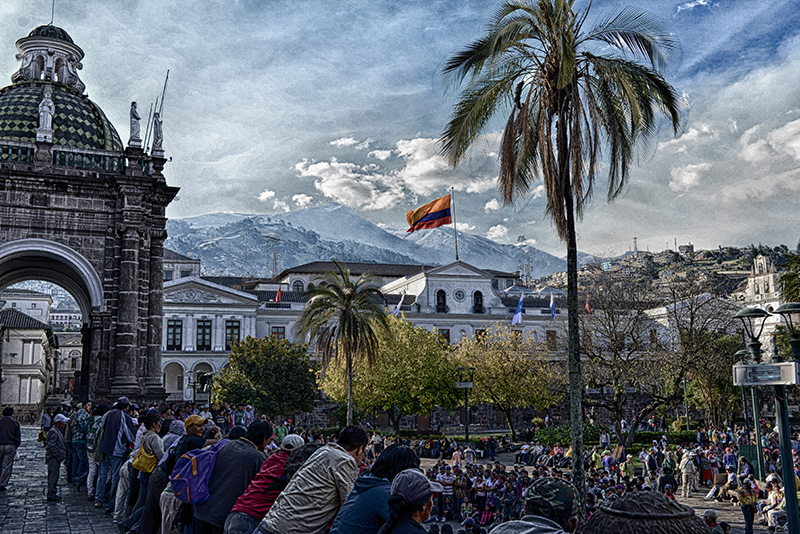The
amazing
story of our trip to Ecuador in 2013.
Index for quick navigation:
Introduction
Quito
The Amazon
Galapagos
The Shipwreck
Introduction
After my father died in June
2013, my wife and I wanted to do something special to get our minds of
things.
After many trips that had a focused on PaleoSeti research we thought it
would be fun to do something different. My wife worked in biological
research all her life so her dream was always to see the Galapagos
Islands in Ecuador were Charles Darwin developed his theory of
evolution.
The Galapagos Islands are a rather expensive place to go and therefore
was always not on top of our list of places.
But we both work hard and have
decent paying jobs and we thought we can treat our self to something
different. The trip should not be completely “PaleoSeti free” of
course, as I always wanted to visit Cuenca and the (in)famous
collection of ancient items from the collection of pater Crespi.
Little did we know that this
trip would be one of the most traumatic experiences of our lives.
Main focus should be the
amazing nature of the Galapagos Islands. We booked a tour online with a
well respected Australian tour operator. Five days on a Cruise ship
among the Galapagos Islands during our three week trip to Ecuador.
Another potential goal was the Amazon and the jungle in the Ecuadorian
lowlands.
Quito
We arrived in Quito, the
capital of Ecuador, on 25. September in the middle of the night. It
seems that most of the flights from North to South America arrive
around midnight, which makes it never easy if you don’t know your way
around. Quito just got a brand new airport. The problem with this new
airport is that the Ecuadorian government just built but forgot to put
the necessary infrastructure around to support it. There is no highway
leading to it nor are there hotels nearby. The closest hotel we could
find online was “just around the corner” as the website stated, but in
reality a 20 minute drive. Without headlights on, of course, this seems
to be an unwritten rule in South America.
Next morning the elderly
gentleman drives us back to the airport, he doesn’t understand that we
want to go to Quito. Either he doesn’t want to understand or he is not
the brightest fellow we have ever met. But no problem we can take a
taxi from the airport which we do. The 20 km taxi ride from the Quito
international (!) airport to downtown Quito is probably the most
convoluted taxi ride to/from and airport in the world. The drivers have
to take back roads and a tiny bridge which is congested with traffic
most of the time.
We booked a Hotel online right in the historic city center of the city.
Quito is proud of the fact that its historic old town was one of the
first dedicated Unesco World Heritage Sites. It’s Sunday and we learn
from the Taxi driver that the old city is closed for car and only open
for bicycles. I bet that’s a first and only in South America.
The first impression of Ecuador is that it is better developed as Peru.
The city looks more “Western”, when we see many big malls and shopping
centers. Ecuador abandoned their currency some years ago in favor of
the US$. To be honest that scares me a little as those countries have a
tendency to be more expensive. The Taxi ride from the airport to Quito
proves this, it’s $20, way more as we would have paid in Peru.
We are getting out in a little
side street and have to walk a couple of city blocks to our hotel “San
Francisco”. The hotel couldn’t be nicer and more central. It’s
absolutely beautiful in an old colonial building.
 |
|
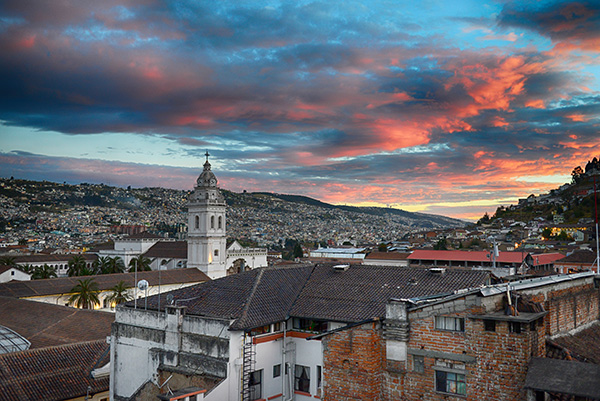 |
| Our hotel
is a wonderful colonial building in the heart of Quito. |
|
On its
roof top terrace we have a great view. |
The historic old town is just a
walk away. The next two days we explore Quito. It turns out that Quito
is a bit of a mixed bag. We love the historic old town, it’s full of
life and has a positive feel to it, the architecture and culture is
absolutely beautiful and definitely worth seeing.
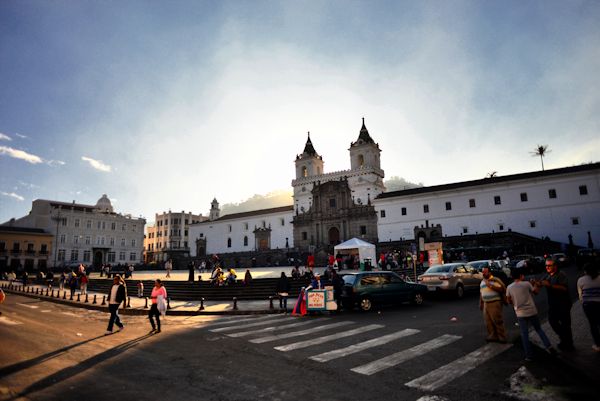 |
|
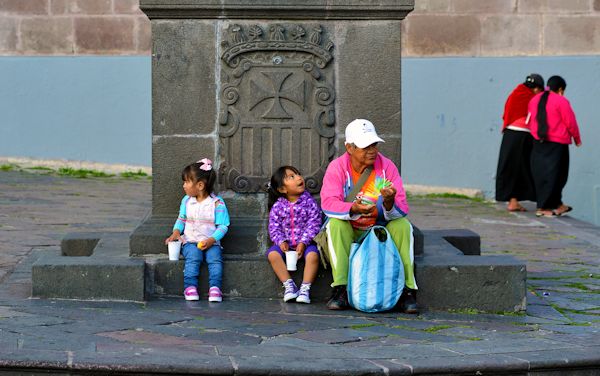 |
| Quito's
plaza San Franzisco. |
|
|
The new bits of town like the
“Madrigal” where many of the tourist are and travel guides say “it’s
happening”, we find tacky, dirty and sleazy. It reminds me of tourist
Mekka’s a la Cancun and Mallorca. The only place in the world where
this kind of stuff is actually charming, is Las Vegas.
The rest of the city is also nothing to write home about. We make a
short trip north of the city to the ‘Mitat del Mundo’ – the middle of
the earth, the site where the equator devides the northern and southern
hemispheres in equal parts. The site is basically just a monument, with
a few tacky tourist attractions around it, but it’s fun to get a photo
while standing on the Equator.
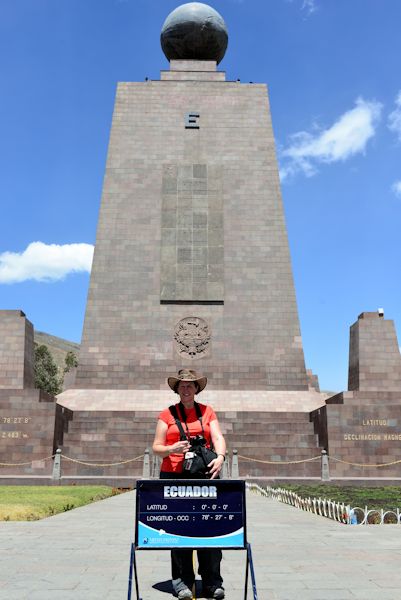 |
|
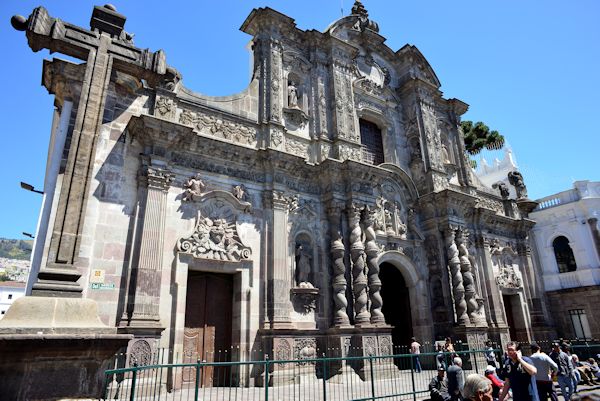 |
| Beth standing right on the Equator. |
|
|
We decide to stay in the
historic part of town which seems like a completely different world.
But this makes up for everything. Beautiful buildings, monasteries,
great little shops, tugged away in walkways and catacombs, fantastic
restaurants and lot’s of history to explore. There are two Museums here
that I have never heard about before, but house fantastic collections.
One is the National Museum of Ecuador, the other is the privately owned
“Casa del Albada”, one of the most tastefully presented collections we
have seen in a long time.
At the end of day two we decide
to book an Amazon jungle tour. It’s shoulder season and it shouldn’t be
a problem to book something like that in Quito. We have a place in
mind, a jungle lodge run by a Swiss company (you know that the Swiss
are known for their ‘jungle fever’) and highly recommended online.
During our last visits in Peru
and Bolivia we found that public transportation and local booking of
tours etc. is a breeze. Somehow we think that would be the same in
Ecuador. How wrong we are! The travel guide describes the Madrigal as
the area where tours are offered in abundance. When we get there,
everything is either closed for the season or the travel agencies moved
out completely. But we find one that is actually open. The girl that
works in there speaks great English, but unfortunately that is her only
helpful trait.
She can book a jungle tour she says but not right now, she needs at
least two weeks notice. Not at all what we experienced in Peru and
Bolivia were everything works and problems get solved in the moment.
After I show her the lodge we want to go to on her computer, I can
convince her to give them a call and see if there is a chance to get us
there. “No, the lodge is fully booked”, she says after she get’s off
the phone. She doesn’t have an alternative despite the fact that our
travel guide lists several lodges in the area and we can feel that she
doesn’t really want to deal with us.
We find another travel agency
and the guy that helps us there is a bit more knowledgeable. He also
says the lodge we want to go to is fully booked. He recommends an
alternative. Deep in the jungle near the Colombian border is a lodge,
where the jungle is still as it should be and kidnappings by local
guerilla groups rarely happen. Wait a minute! Rarely happen? That
does not sound promising. We are certainly adventurous, but six month
in the jungle kidnapped by a Colombian guerilla group and fingernails
pulled off does not sound like time well spent. Although it rarely happens…
We are disappointed about the
lack of enthusiasm from the local tour agencies to get us to the
Amazon. It can’t be that difficult. Or were we just spoiled in Peru? We
are going back to the hotel and see if we can arrange something over
the Internet. We find an interesting lodge, run by a local tribe. The
website says, the lodge is completely run by locals and proceeds
support the local community. The project is also a school to provide
local youth to get experience in the tourism and hotel business. They
have a office in Quito. We decide to go there and see if we can go to
book something directly without going through a travel agent.
This time we have more success.
The lady that deals with us is very friendly and helpful. The lodge has
openings and we get a good deal as they just renovated and rebuilt the
place. Not everything is a 100% done she says, but they are open for
business.
To get to the lodge is a bit of an adventure, first we have to take the
bus to Tena - that’s Ecuadors gateway town to the Amazon - then take a
bus to little river village and from there we have to take a canoe
upriver to the lodge. She says it’s important to arrive on time, as the
canoe can’t drive in darkness, that’s too dangerous.
The Amazon
Next morning we are on the bus
to Tena. We are excited. The trip sounds like it’s going to be a real
adventure. We find another seemingly small difference to Peru: The
buses in Ecuador don’t have washrooms, which can be a big deal on a 5
hour bus ride! The result of this is that after 2 three hours, the bus
stops pretty much every 20 minutes for somebody else. We are worried
that we won’t get to Tena in time to catch the next bus that brings us
to our canoe.
When we arrive in Tena we find
out what chaos really means. The main bus station is filthy and the
most chaotic, unorganized place I’ve ever come a crossed. Wait! One
place in South Africa was just as bad.
Despite our best efforts we
can’t find the bus that our “tour lady” told us in Quito. We find out
later that the reason for this is not just the chaos, it’s the wrong
information that the lady gave us. There is no bus at this time at all
to where we want to go.
We have no choice but to enter what we believe is a Taxi who’s driver
offers us to drive the 120km we have to go. I know he will rip us off
money wise, it’s just a matter how much. We will see when we get there.
The bus had a delay and the 120 km have to be made in about 1.5 hours.
The driver puts the pedal to the medal. We are going way to fast,
100km/h on jungle dirt tracks are not really a save option. I just
close my eyes and hope for the best.
As expected the driver charges way too much for the trip for South
American standards. We don’t care, at least we are here. I’m sure he
will stop working for the next three month because he found stupid
tourists that actually paid what he asked. Whatever, I’m sure “Karma”
will set him straight further down the road. Literally.
We are now standing in a tiny
village right on the Napo river that is a part of the mighty Amazon.
Wow! We are here. The canoe is still here as well. They were waiting
for our arrival, the Taxi driver called ahead on his cell phone. In
situations like these I don’t know what to think about cell phones
(handys for our German readership). It seems that cell phone coverage
is pretty much everywhere in the world now. Even here in a very remote
corner of the Amazon. It’s certainly a blessing for the locals that can
communicate with friends and family like never before.
For our situation communication
was certainly helpful, as we would have been stranded in the tiny
jungle village until the next day if the canoe already left.
The flipside of this is certainly that for the traveler that looks for
it, nothing is a real adventure anymore. The other problem is that now
all over the world, poor people strive to have a cell phone first,
before they buy clothes for their children or send them to school. A
bit of a scary though. The Taxi driver tells me that a cell phone bill
is about $50 per month, a huge amount of money considering what the
people of 3rd world countries make. But it seems everybody has a cell
phone here. Even in the remotest straw hut we spotted Android and Apple
logos.
No matter if you like this development or not, it’s a fact and this
rolling train nobody will stop.
The Canoe that will bring is to
the lodge is quite long to provide stability on the river. The motor is
quite powerful and carries the two of us and two locals up river. The
canoe is also acting like a Taxi along the river. I’m sure today we are
paying for everybody, nobody seems to pay when they get in or out.
 |
|
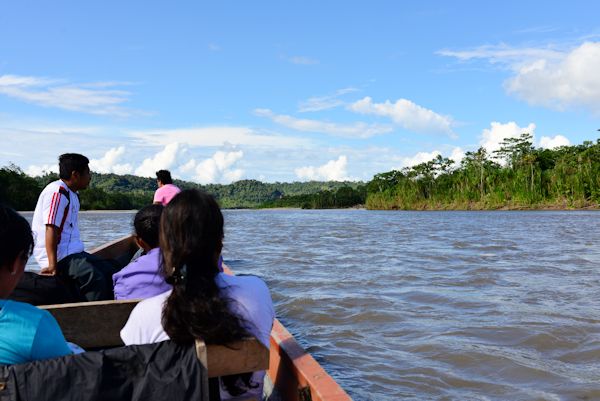 |
| From a
tiny jungle village we take off to our lodge. |
|
Canoes
serve as Taxis on the Amazon river. |
The lady we booked the tour
with told us it’s a 2 hour long trip to the lodge, but after the
misinformation about the bus, I start to doubt what she said. Sure
enough, after 50 minutes we arrive. The roofs of the lodge’s cabins are
barely visible among the thick jungle canvas that covers a hill next to
the river.
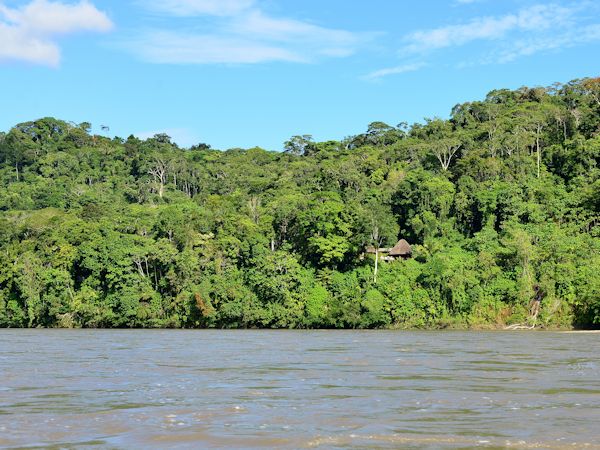 |
|
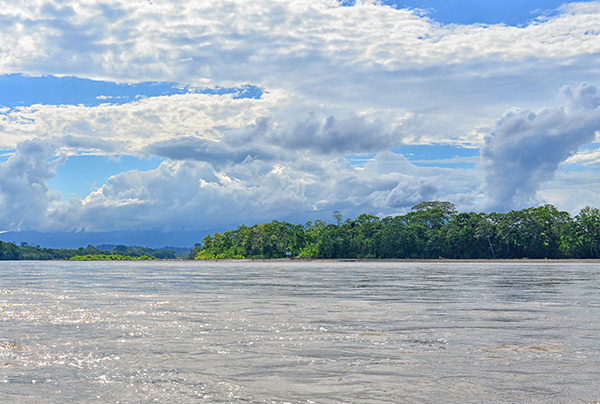 |
| Our lodge
is right in those trees. |
|
|
There are two girls in the
water, judging by their skin color fellow tourists. One girl is from
Austria the other from the Netherlands. A guide welcomes us. We are
loaded on a pickup truck and brought up some dirt roads to the lodge.
The lodge is a surprise,
everything is very open concept. There are seven cabins built on the
hillside. The inside of the cabins is simple, but very nice
nevertheless. Our cabin is as clean as the jungle environment allows.
There is a nice washroom with hot and cold water. The guide tells us
the water is filtered but we brought our own purifier just in case.
Plastic bottles are not allowed here, the lodge is considered
ecological sustainable.
Our cabin has a fantastic view. We are overlooking the river bend. We
have a nice balcony with two hammocks. Exotic jungle noises are all
around us. What else do you need?
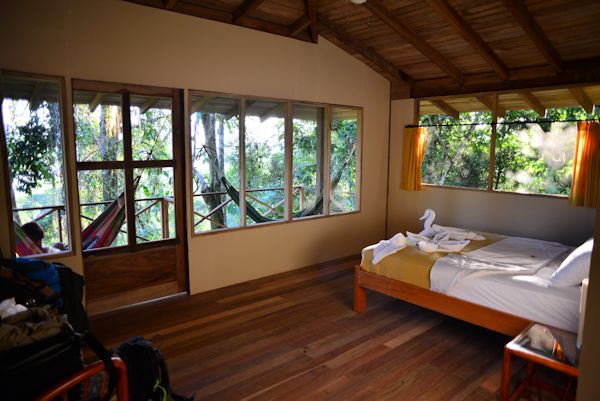 |
|
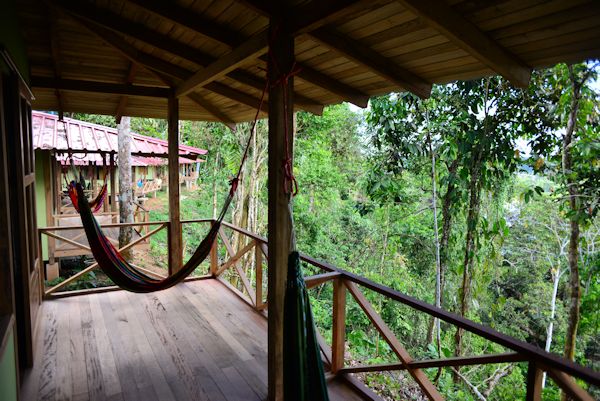
|
|
|
|
One thing we are a bit worried
about is the food. In third world countries, eating the wrong food can
ruin your hard earned vacation pretty quick. On our 2005 trip to
Mexico, Beth was sick for three days at the end of our vacation because
of bad food. She couldn’t even leave the room.
Ever since then we are extremely careful what we eat. We usually avoid
salads and everything that isn’t served hot.
Here avoiding food will be
difficult as there is no food around except what comes out of the
kitchen. There is no menu to choose from, they cook what they cook.
Besides us there are five other guests. Two women from Austria, a
volunteer from the USA, and a Dutch girl that wants to learn Spanish as
well as her Ecuadorian teacher. Our guide for the next four days and
three more staff that take care of the premises and the kitchen.
Here avoiding food will be
difficult as there is no food around except what comes out of the
kitchen. There is no menu to choose from, they cook what they cook.
Besides us there are five other guests. Two women from Austria, a
volunteer from the USA, and a Dutch girl that wants to learn Spanish as
well as her Ecuadorian teacher. Our guide for the next four days and
three more staff that take care of the premises and the kitchen.
Dinner is served and what can I
say? The food we get served is as good as any food we have ever eaten
even in the best restaurants. Just fantastic! One day they caught a
huge catfish right from the river and freshly prepared it for dinner in
the evening.
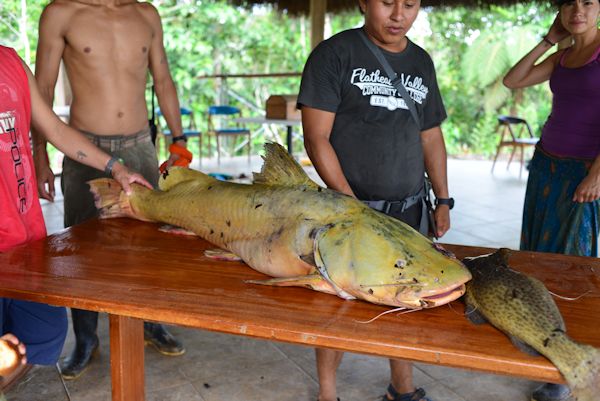 |
|
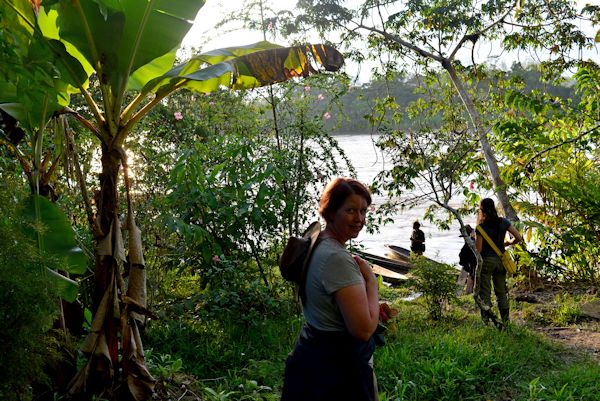
|
| Dinner! No
supermarkets needed. Everything is fresh from the river. |
|
In the
morning we set out on a mini expedition into the Jungle. |
Every day the guide prepares a
program for us. We have to cross streams to get a hidden waterfall
paradise, get introduced to the local community, visit a farm and learn
a lot about the jungle, what ants you can eat, what spiders to avoid
and what plants are used to make powerful toxins.
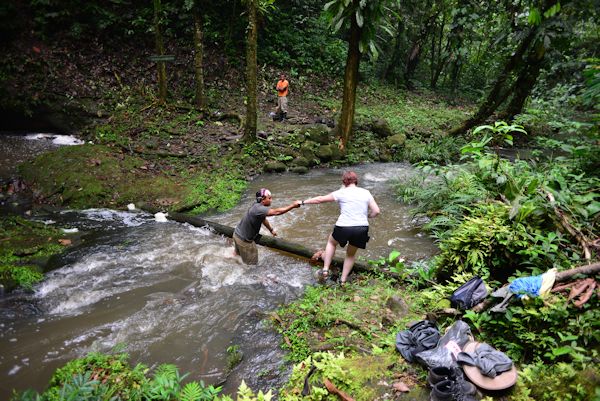 |
|

|
| The jungle
path is quite tricky to negotiate, but... |
|
...leads
us to a hidden waterfall like in paradise. |
We do a nightly jungle
excursion with poisonous banana spiders reflecting our flashlight’s
beams with their eyes and scorpions on the way.
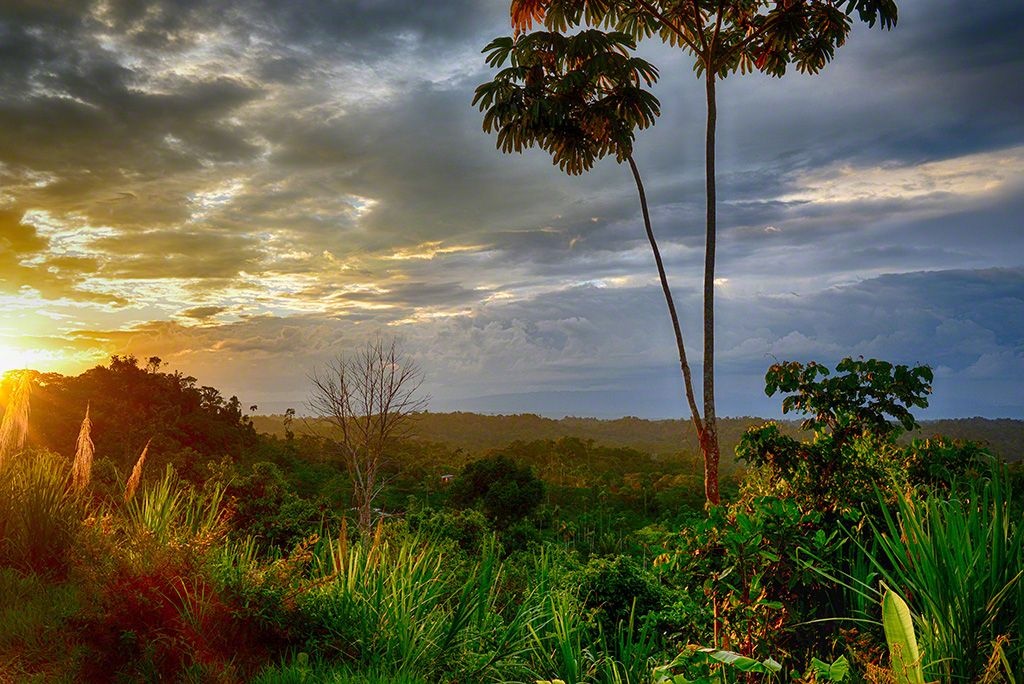 |
|
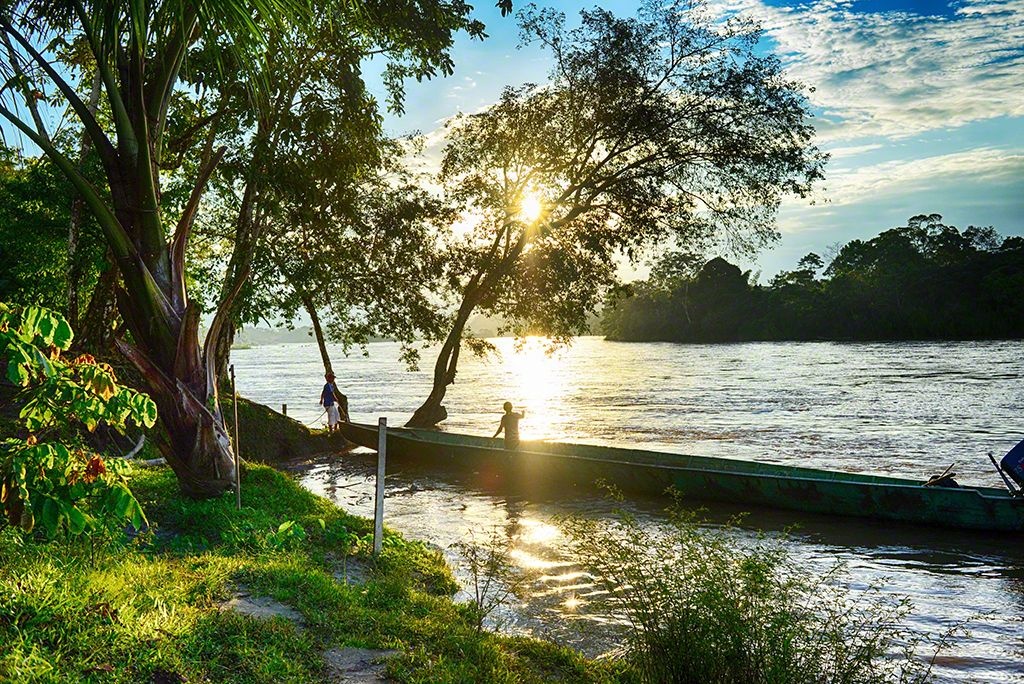
|
| Sunsets
over the jungle are especially beautiful. |
|
We catch
the last canoe back to the lodge. |
We made chocolate from the tree
right next to the kitchen.
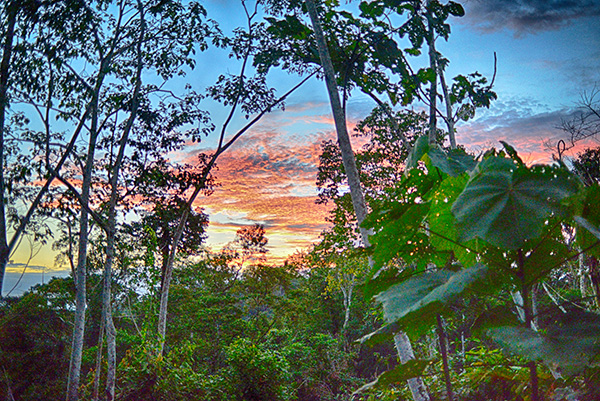 |
|
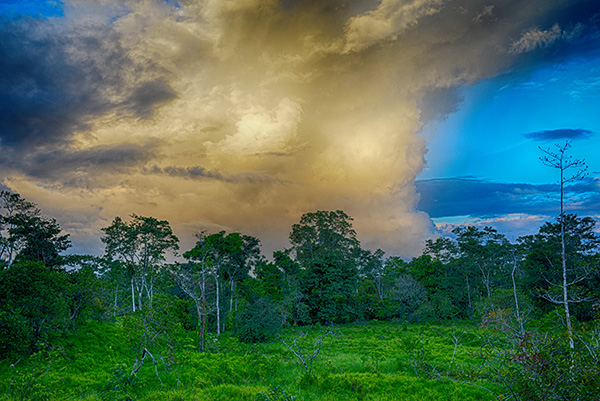
|
| During the
evening hours the setting sun turns the jungle into a sureal landscape |
|
The clouds
and the vegetation turn everything around us into scenes from Arthur
Conan Doyle's "Lost world" |
We had four excellent, relaxing
and fun filled days.
We make our way back to Quito, to embark on our next adventure to the
Galapagos Islands which we look very much forward to.
Back in our hotel in Quito we
are briefed by a representative of our tour operator. We meet other
tourist that will be with us on the cruise, a couple from Canada. There
is supposed to be another lady from Australia here as well, but she
doesn’t show up. Tomorrow our trip starts at 4:00am and our plane to
the Galapagos leaves at 6:30am.
Galapagos
In the morning we get up at an
ungodly 3:00am. We are meeting the fellow group members down in the
lobby including the lady from Australia that arrived at midnight after
a 48 hour plane, bus and taxi ride. Needless to say she looks very
tired. She tells us her story of mishaps that happened to her in the
last two days. Well, it shouldn’t stop here, but we will get to that.
At 4:00am sharp our minivan
leaves direction airport. We embark the plane and two hours later land
at the tiny airport on the Island of Bartolome. The airport was built
by the US forces in World War II and the runway is still unchanged. The
Ecuadorian government invested in a new building for the passengers to
embark, but that’s about it. The Island is so small it really only
holds three planes. The weather is beautiful, warm and a slight breeze
is blowing. Beth is so happy, her Galapagos dream finally came true.
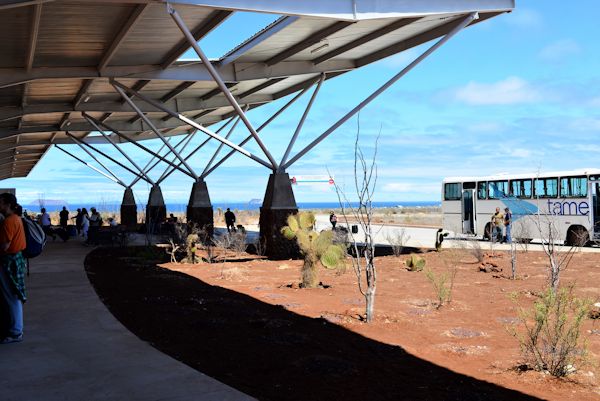
|
|
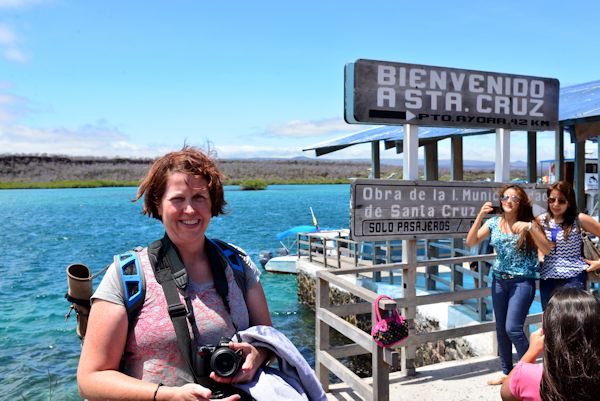
|
| The
airport on the tiny island of Baltra. |
|
Welcome to
the island of Santa Cruz. |
Outside the
naturalist guide is waiting. One can only visit the Galapagos Islands
with a Naturalist guide. We are brought to the town of Puerto Ayora on
the Island of Santa Cruz. There our cruise ship is waiting for us.
Right in the town of Puerto Ayora you can see how special the Galapagos
Islands are. Right where the fishermen unload their catch, pelicans and
sea lions are sitting without fear right next to people.
This is the ‘specialty’ of the
Galapagos Islands. Somehow evolution took away the fear of each other
from all the creatures big and small. No animal runs away from another,
not even from humans. In the middle of the harbor seabirds, sea lions
and iguanas are next to each other and roast in the sun. It’s sometimes
quite the surreal sight.
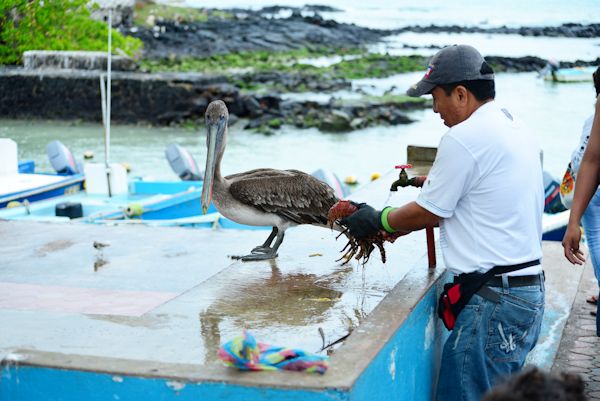
|
|
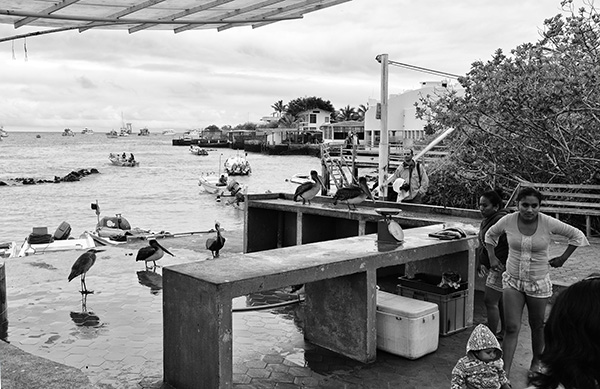
|
| The
fishermen wash their catch and are closely watched by all kinds of
feathered friends. |
|
Nowhere
els in the world do humans and wild animals life so close together
without any fear. |
The weather here changes
quickly and we are on the edge of the rainy season. Clouds are rolling
in when we wait for the little dingy that will bring us to our cruise
ship. Cruise ships in the Galapagos are more like yachts, about 30
meters in length and designed for about 30 passengers. Dozens of them
are anchored in the harbor of Puerto Ayora and wait for their paying
customers. The Ecuadorian government strictly controls the number of
boats and tour operators in the Galapagos. This results in pretty high
prices if you want to go on such a cruise. The Islands are protected by
a national park system and you have to pay a $100 national park fee
right when you arrive at the airport. To get to the cruise ships rubber
dingys with outboard motors are used and if the sea is rough it can be
quite a challenge for everybody to get in and out of the boat.
Our Tour guide – they like to
call themselves Naturalist guides – is named Diego and my first
impression of him is that he is a bit grouchy, like quite a few
Ecuadorians we have met on our trip. There is definitely a difference
in mentality and attitude between Peruvians and Ecuadorians, quite
surprising as the two countries are so close together. Diego is not the
friendliest person we have ever met, but he is not unfriendly either.
It looks like he wants to come across ‘professional and all business’
to us ‘westerners’. This doesn’t really work very well, especially when
he tries to sneak away to flirt with the two young Ecuadorian travel
agents in training that want to experience the tours they will sell in
the future for the first time themselves.
But overall he is very
knowledgeable when people ask questions.
We get on our dingy and reach
our destination, the cruise ship ‘Pelikano’ after about 5 minutes. The
sea is a bit rough and the dingy is pounding on the waves. Everybody
struggles to get out of the dingy onto the ship. The dingy operator is
very skilled to maneuver the waves to make it as easy as possible to
for all the passengers to get out. The Australian lady from our hotel –
she is in her late 60s – almost falls into the sea. She is up for a
good 56 hours by now, boy she must be tired. Once on the ship we meet
our fellow tour mates: A couple from Denmark, two young girls from
Sweden, the Canadian couple from our hotel, a fellow from England and
the Australian lady. Altogether we are a group of 10 tourists that will
spend the next 5 days together on that relatively small ship. There are
also 5 crew members on board. The captain, a cook, the naturalist
guide, a mechanic and a helper.
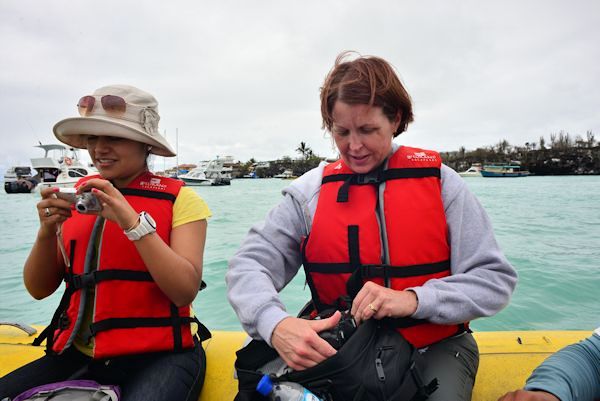
|
|
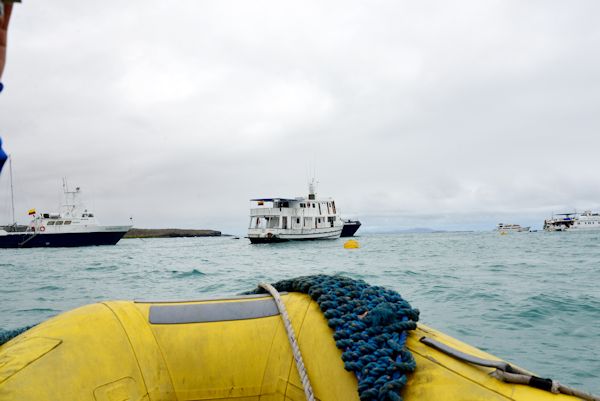
|
| Our group
is getting transferred to the ship in rubber dingys. |
|
Our cruise
ship, the 'Pelicano'. |
We are instructed that we can’t
wear shoes on board, they have to be deposited in a cubby hole in the
back of the ship. The cubby hole can’t be missed, the smell will give
it away. The ship has 16 cabins, each cabin features a bunk bed and a
private bathroom with running hot and cold water, a shower, a sink and
a toilet. We all move in our cabins and store our things. I’m a bit
surprised that we don’t get a safety briefing of some sort but the life
vests in our cabin at the end of the bed are pretty self-explanatory.
No words can describe how
excited we are. Everybody on the ship feels the same way, the
atmosphere is filled with excitement and fun. We get shown the ship’s
common/lunch room that features a spot for a buffett, two large tables
and a big screen TV. Why somebody would like to watch TV here with all
the nature around is beyond me. Maybe this is more for the crew when we
are on land excursions. One of which starts right away.
We are brought to shore again
to visit the famous ‘Charles Darwin Research Station’. Here a breeding
program for endangered Galapagos species is run by several
Universities. Volunteers from all over the world pay good money to help
out at the station for months. The part of the station that is
accessible for tourists is similar to a small zoo, you can see Giant
tortoises, Iguanas in various ages in their enclosures. The tour lasts
about an hour and is ok. To be honest we both expected a bit more, I
think it would be a good idea if somebody would have shown us a bit
more about the applied science that’s going on here. But it was
certainly a nice experience to just see the famous station one can read
so much about.
We stroll back to the harbor
through the town of Puerto Ayoras. The town is a weird but charming mix
of art community, tourist trap and ‘sleepy province nest’.
We are going back to the ship
on the dingy. It’s slowly getting dark. Laurel – the lady from
Australia now up for sixty consecutive hours – says she better lay down
for an hour. We agree.
It’s already dark when the crew
invites us – fully dressed in their best uniforms – for an evening
cocktail. We are getting a briefing on what’s in store for us tomorrow.
After that dinner is served. It’s amazing what the cook is able to
produce in his tiny kitchen. A three course meal for 15 people. Not
bad. And tasty, too.

|
|
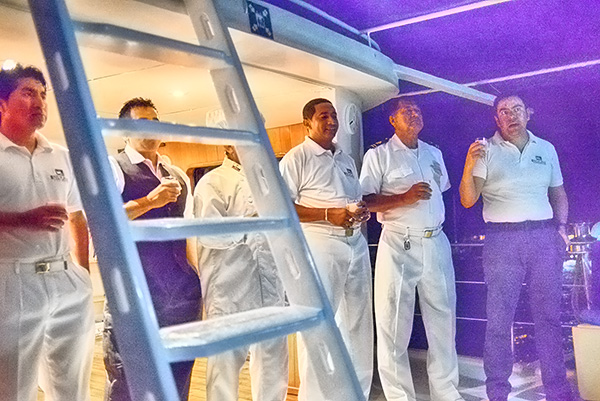
|
| Contemplating
in the bar. |
|
The crew
including the captain. |
During the briefing we are
getting told that the ship will navigate to it’s daily destination
during the night. That way we will be where we want to be when we wake
up. We are warned that during this time of the year the sea can be a
bit rough, so we might have a bit of a bumpy night.
They were not kidding. We lay
down, but it’s hard to fall asleep. The ship rolls and bounces quite
heavily. The ship’s Diesel engine roars and vibrates the ship even
more. But I find the sound of diesel engines soothing after while. It
takes us both several hours to fall asleep. I’m surprised that none of
us is seasick with such heavy seas.
Next morning we wake up and the
sun is shining. We anchored right in front of an island with nice white
beaches and turquoise seas. When I get out of our cabin I feel a bit
like James Cook but without the uniform. But only for a few seconds.
Laurel walks on the side of the ship, slips and falls straight on the
back of her head. She bangs it pretty good and has a big bump on her
head. I get the feeling that she is a bit of a ‘Schlamassel’ an old
Jewish-German word for somebody who has constantly bad luck. She is ok,
though, a bit dizzy. She should probably take it easy and lay down, I’m
sure she has a concussion. But she won’t and there is nothing we can do.
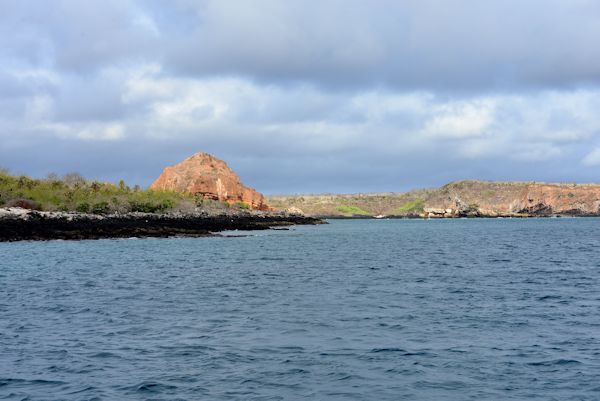
|
|
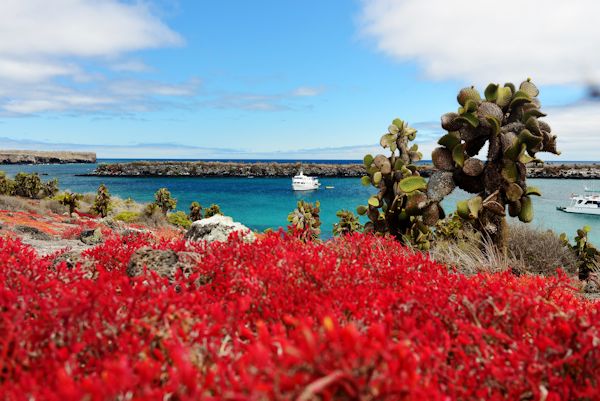
|
| Our first
stop |
|
Once the
sun comes out, the islands display incredible colors. |
The turquoise sea around us is
filled with live. No matter where you look into the water, you can spot
colorful fish. Sharks are circling, we can see them if we look straight
down. The water is so clear, it’s hard to judge how deep it is. I would
say about 10 meters.
If we look over to the island
we see sea lions lying on the beach. Frigatebirds are circling
overhead. I had no idea how big they actually are. They must have wing
span of 2 meters. Some Pelicans are swimming next to the ship and watch
us very closely, I guess they are waiting for the kitchen scraps.
The crew is getting the dingy ready to bring us to the island. We enter
the dingy in groups e of four and land on a small walkway. Right away
we are surrounded by hundreds of animals of different shapes and sizes.
Birds like the famous Darwin finches, Iguanas and Sea Lions are all
around us, completely without fear. The guide is excited because right
in front of us is a very rare Iguana that is a hybrid between a land
and a sea Iguana. I have to admit I know very little about animals, I’m
more an archaeology enthusiast, but even as an ignoramus I thoroughly
enjoy myself. It is really unique here and for a camera nut like myself
there are endless opportunities.
We hike around the island for
about an hour before we go back to the ship. We are navigating to an
island nearby where we can snorkel with sea turtles. Beth and I never
snorkeled before so we are really looking forward to that. We have
lunch during the ship sailing to the other island.
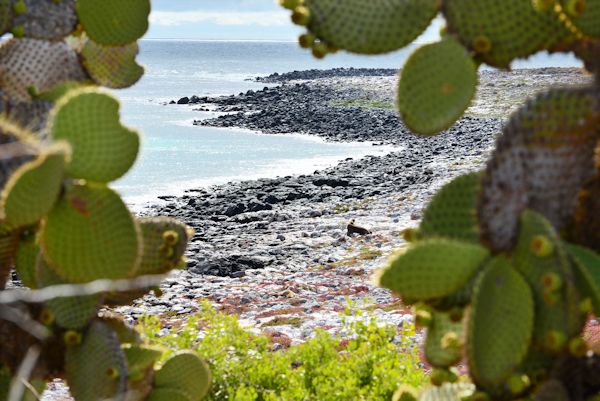
|
|
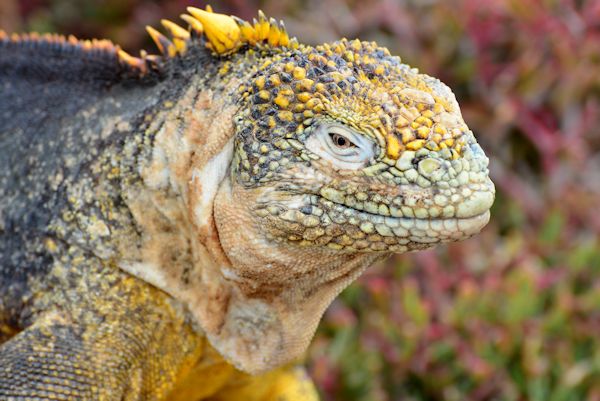
|
|
|
Only on
the Galapagos you can get so close. |
When we arrive we anchor in a
nice sheltered bay. There are sandy beaches around us. On the beach
across the ship I see a big colony of sea lions warming up in the sun.
We are handed wet suits, flippers, diving masks and get rudimentary
instructions on snorkeling. I snorkeled before, but it’s Beth’s first
time. I can tell she is a bit nervous. We hop in the water, it’s nice
and warm and the wetsuits make it quite comfortable. We bought two
underwater cameras for this trip, Beth has a modern digital camera, I
have an old fashioned Nikonos underwater model from the late 1980s. Our
guide swims ahead, today we have the strong feeling he is really bored
with everything and his mind is again more with flirting with the two
Ecuadorian girls – now in sexy bikinis – than helping us around. Laurel
gives up after 10 minutes and swims back to the boat. Beth and I swim
together and explore the underwater world. The water is a bit murkier
now as the wind picked up a bit and sediments from the ocean floor get
picked up. Visibility is a bit reduced. But nevertheless we have a
great time, see sea turtles and many colorful fish I only knew from
aquariums and pet shops.
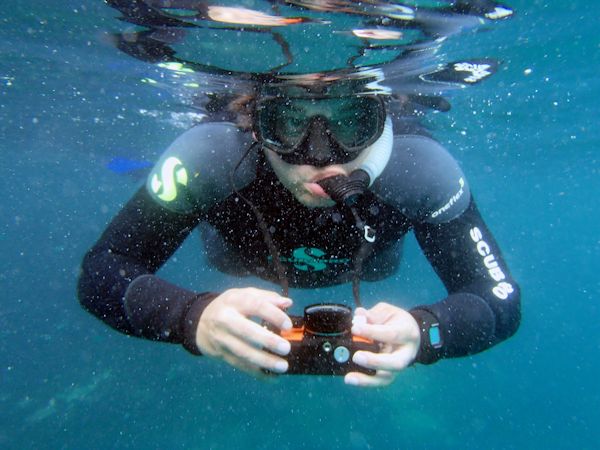
|
|
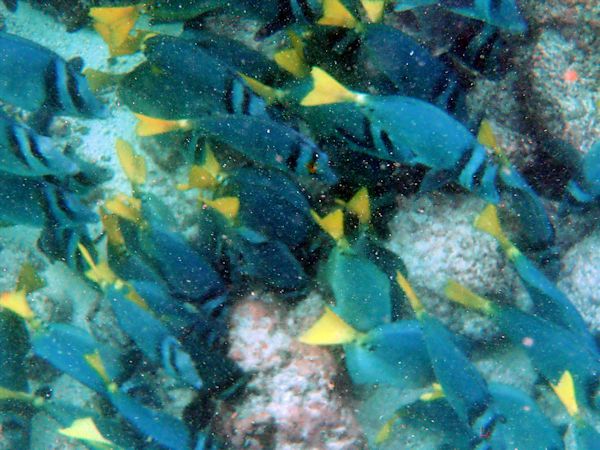
|
| My first
underwater portrait. |
|
It's like
in an aquarium. |
After a while we get exhausted
and we are quite far away from the ship as the guide screams to get
back to the ship. He says, if anybody wants a ride back to the ship in
the dingy, please wave. Many wave, but he is already revving up the
outboard motor and goes back to the ship. Maybe the two girls needed
his help more than we did. We swim back slightly annoyed, but decide
not to complain. What good would it do?
We all make it back to the ship
20 minutes later. The currents are stronger as expected. We get dried
up and get ready for another land excursion over to the sandy beach
with the sea lions. Once there we are among docents of them. We are so
close it’s almost unreal. What an incredible experience. Many of them
have calves or are close to giving birth. Hawks are sitting on the
bushes around the beach, they are waiting for the afterbirth of the
newborns. Apparently this provides them with a nutritional meal. Not
even the hawks fly away when we approach them. They just look at you as
if they would say “What?”
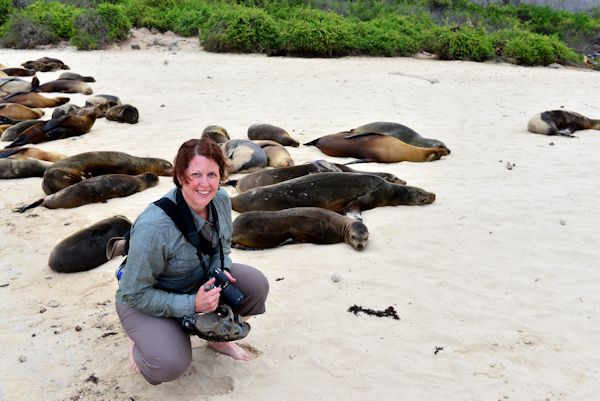
|
|
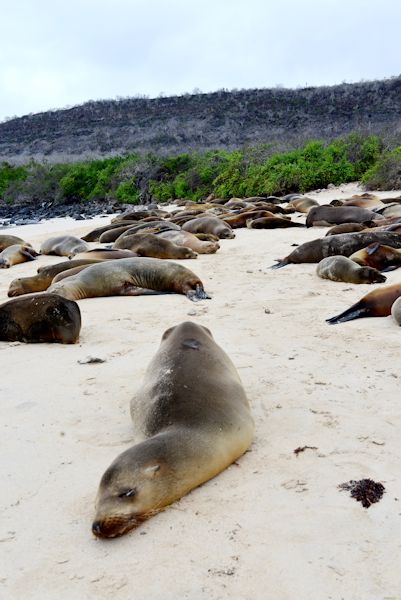
|
Above:
Beth among the Sea Lions on the beach.
Only on the Galapagos you can get so close. |
|
Sea Lions
everywhere!
They are cute, but look nicer then they smell... |
It’s about 5:00pm now and we
see dark clouds in the distance. Signs of a bit of a storm coming. We
are all hungry and we get transported back to the ship.
We are getting news that one of
the crew members is sick with ‘an allergy’ and he is in bed. We saw him
today sneezing and coughing. We are getting an uneasy feeling, diseases
spread quickly on ships. Beth and I both work in a communicable disease
laboratory, we know how fast things like those can get out of hand in
confined spaces. The crew member was responsible for serving and the
food, so that doesn’t help either.
But nobody else seems to be
worried, so we keep our concerns to ourselves. Everybody is going to
bed at 8:00pm. Hiking and snorkeling tired everybody out.
The sea is getting really rough
now. It’s raining outside, the ships rolls and pitches heavily. We are
navigating in open seas and in the briefing we were told that we should
arrive at our next destination by about midnight. I fall asleep, but
wake up around 10:00pm, because the engine stopped. I get up to look
outside. Are we already at our new destination? I see a set of lights a
bit off the ship, they must belong to another ship. I see the dingy
leaving from our ship with three people on it. The operator of the
outboard motor and two others, one of them has a blanked rapped around
him. I’m convinced, the crew member is seriously ill and needs to get
off the ship. We are very uneasy. But since there is absolutely nothing
we can do about it, we are going back to bed. I dose off.
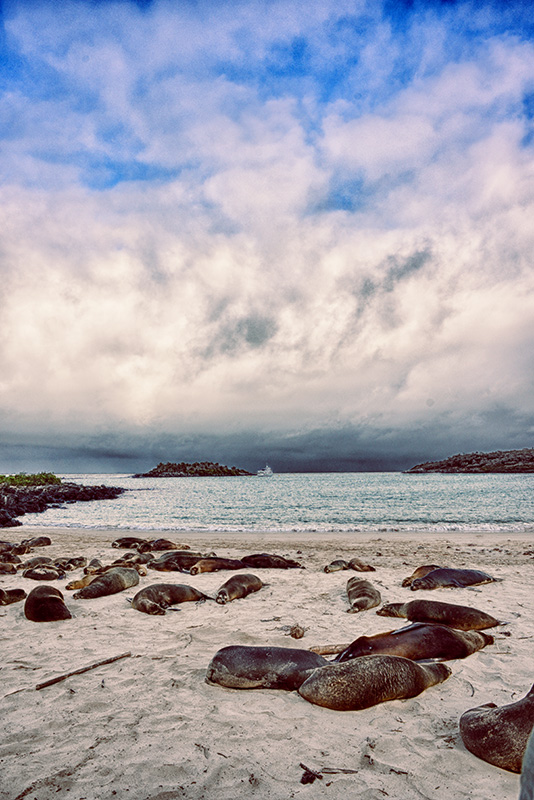
|
|
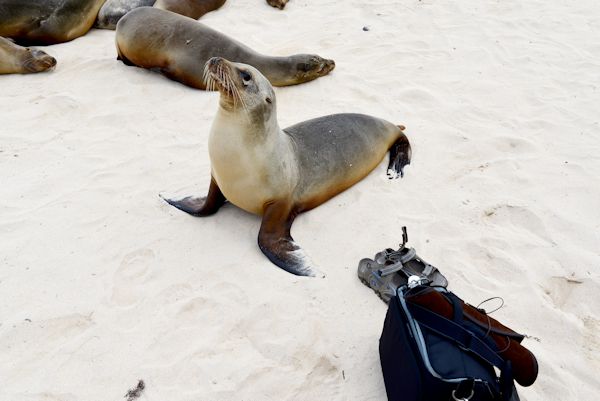
A female Sea Lion is guarding my
camera bag thinking it's her pup.
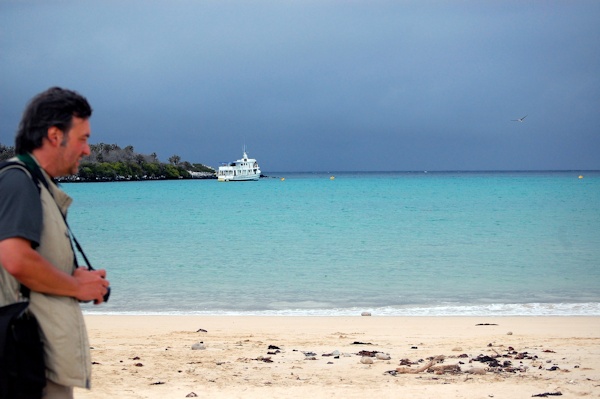 |
| A storm is
brewing on the horizon. |
|
The last
photo of the 'Pelikano' above the waves. |
The
Shipwreck
A big bang and a nasty
crunching noise wakes us both up. A quick check of the watch reveals
it’s 1:00am in the morning. I jump out of bed and yell “What the hell
was that?” I’m wide awake. Beth is up as well. I open the cabin door.
It’s a bit foggy out and all I can see is a beam of lighthouse turning
above the ship. The engine of the ship is roaring. Now I can see that
the ship is sitting on a cliff. The sea is rough and the rocks the ship
up and down. I can hear the rock scratching on the ship’s hull. I can’t
believe it, we struck a rock! I turn around in the cabin and tell Beth.
Dennis, the other guy from Canada stands in his cabin door as well. A
crew member runs up and down, screaming hysterically. From the back of
the boat I hear Spanish “Rapido! Rapido!” and other things I can’t make
out. I get a glimpse of somebody in the back of the boat working on one
of the dingys of which we have two. Another crew member runs around in
his underwear. I look at Dennis, he looks at me. Almost in unison we
say “I think we should get our live vests on…” I turn around and tell
Beth, “get your live vest on, this is serious.” As I say this and grab
my vest, I hear a gurgling noise.
It’s a very distinct sound I
heard
before from Offroad vehicles with diesel engines when they are getting
submerged in water and the air intake sucks in water. Two seconds later
the engine sound seizes and the lights turn off. Now I know we are in
serious trouble. “We should grab everything we can”, Beth says. I pack
my camera bag, we both get our emergency headlamps out that we always
carry with us. I will never go anywhere without one since my Peru trip
in 2004. My backpack is only partly packed and it’s not zipped up. I
can feel the ship tilting. “Beth, we have to go!”, I shout. “Yes”, she
says, “I’m coming!”. I get out the door, turn to the right, the back of
the ship. It’s pitch black, the only thing I see is what is illuminated
by my headlight and the beam of the lighthouse over our heads. The crew
is screaming “Rapido! Rapido”. I see the waves crashing over the side
of the ship. Debris is floating on the water. The crew member in the
dingy shouts at me “Rapido! Rapido!” I turn around to check on Beth.
She is not there! Oh my god, she is not there! I shout her name. “BETH,
BETH”. At this moment a big wave crashes of the side of the ship. I
slip and fall and get banged onto the railing of the boat. The railing
is almost entirely under water. I try to get up, but my backpack pulls
me back. I fall again. “BETH, BETH!”, I shout again. “I’m here, I’m
here”, I hear her, but I can’t see her.
The weight of the backpack
doesn’t allow me to get up. I manage to take it off, look back I can
see it being swept over the side of the ship. I’m almost completely
under water, but now I can get up. I see Beth, she is standing on the
other side of the ship, holding on. The dingy is now only a meter away
from me. “Rapido! Rapido!” the crew member shouts. I see Beth, that’s
the only thing I can think of is Beth. I manage to get up, Beth is
coming towards me. I grab a hold of her, she grabs me and we both land
in the Dingy head first. Seconds later, Dennis and Rachel, the couple
from Canada slide into the Dingy as well. The couple from Denmark is
already here including a crew member operating the outboard motor. My
first instinct is that we should go towards the rocks we just hit, but
we might get smashed against them and get injured really bad. And god
knows where we are. This could be just a tiny rock in the middle of
nowhere. The second dingy is brought up with another crew member on
board. It’s the guide. He says, we have to transfer to the second
dingy. I see that it has no engine and a big hole in the floor where
the engine would sit. We climb over. Beth and I are the only ones with
flashlights. I look back to the ship, it’s tilted in a 30 degree angle.
Only tiny position lights are on. No emergency horn, nothing. “Where
are all the others?”, I shout. “We are going back to get them with the
engine-boat”, the guide says. “Good plan!”, I say. “Can I have your
flashlight”, he says. I give him my light. And they head off. A few
minutes later I see an inflatable emergency island drifting towards us
pulled by the dingy.
We all transfer into the
island. It’s one of those
octagonal thingies you see in movies with the knowledge that you will
never see one for yourself, let alone be in one. The contraption is
partially filled with water which moves back and forth as people shift
around among the thin rubber floor, but for now it is the safest place
on earth. We look around, and we are all there. Everybody managed to
get of the ship! We look back to the ship and I can see it sink by it’s
side! I notice that the emergency light on my life vest blinks. Those
are only activated if they get submerged in water. Now I realize, that
we are still alive, I give Beth a kiss and a hug. I also realize, that
I somehow managed to hold on to my camera bag. Beth managed to grab
most of her stuff, that’s why she was just a few seconds behind me and
I couldn’t see her at first. Now we are a drift in the emergency raft.
One of the crew members is crying, all the passengers are surprisingly
calm. There is shock and disbelieve on everybody’s face. “Did you
manage to call for help?” I ask the guide. “I don’t know…”, he says. He
is the only crew member that stayed relatively calm so far. Now there
is nothing that we can see. The lighthouse beam get’s further away. It
is the only source of light next to our two flashlights. Now the crew
asks for Beth’s light as well. She gives it to them. They are using the
lights to wave around. They hope to attract other ships.
I realize now that we are
reeking of Diesel fuel, the tank of ship must have leaked out. My leg
hurts, I scraped the skin when I was falling down.
I can’t believe it. How can
this happen nowadays? With all the modern communication equipment, GPS
sonar, radar, satellite phones and wireless radio. And yet, we are
waving simple flashlights into the night. I already see myself talking
to a Volleyball when Beth asks “What was that? Did you feel that?” Yes,
I feel it as well, something is brushing against our bottoms, we can
feel it through the thin rubber skin of the raft. My first thought is
sea grass or kelp of some sort, but I think Beth has it right when she
thinks those are sharks. On the day before we were told they feed at
night and are attracted to sounds of distress. We whisper a sarcastic
“Awesome!”, but we don’t want alert anybody else. Let’s not think about
it.
We are a drift for about 15
minutes that feel like hours as somebody says, “There is a ship!”. A
few minutes later there is a good size cruise ship along side of us
named “The queen of the Galapagos”. It’s brightly lit with all search
lights on. It’s the most beautiful thing I have ever seen. A big thigh
of relive overcomes me, I shout “It’s the Carpathia!”. Everyone laughs,
they all feel the same way. The crew of the Queen of the Galapagos
helps us on board. They couldn’t be nicer. We get handed blankets and
warm drinks. It’s pretty chilly, and we are soaking wet. But I don’t
feel cold. We are all under shock and sit down in the lobby. Now you
can see how everybody’s stress and shock releases differently. Beth
starts crying, the Danish couple just sit there and have a void stare
on their face. The guy from Britain is holding his side, he looks like
he is in a lot of pain. I ask if he is ok, he lifts his shirt up and
reveals a big bruise on his rib cage. I think he has a cracked rib. He
was in his cabin until the last minute he tells me. He took a sleeping
pill last night as he couldn’t sleep the night before because of the
rough seas. When he finally woke up, his cabin was half filled with
water, with things floating beside him.
Laurel, the Australian lady,
lost everything she had. She only saved herself. She only wears her
night gown. Like the British guy she was one of the last ones of the
ship.
Beth calms down a bit and we do
a little inventory. I lost my backpack with all most of my clothes, our
water purifier, a Rolleiflex camera, my underwater camera, an Ipod,
watch, etc. Beth has most of her stuff including her camera. We both
lost all our shoes, we are barefoot like all the other tourists on
board. The clothes I have on are a t-shirt, convertible pants (thank
god the lower half of my pants are in the pockets). Before the trip I
bought a travel vest with lot’s of pockets. Thank god I wore it on me
as it contains our passports. Those we check first. Both are wet, but
the German passport is well made, with the important part laminated and
waterproof. Beth’s Canadian passport is damaged on the photo. The ink
from one half of the photo bled out.
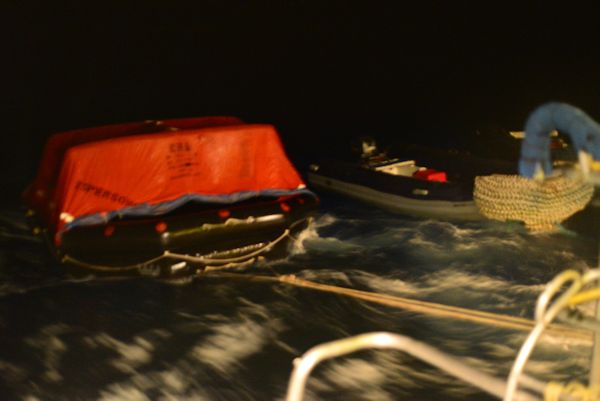
|
|
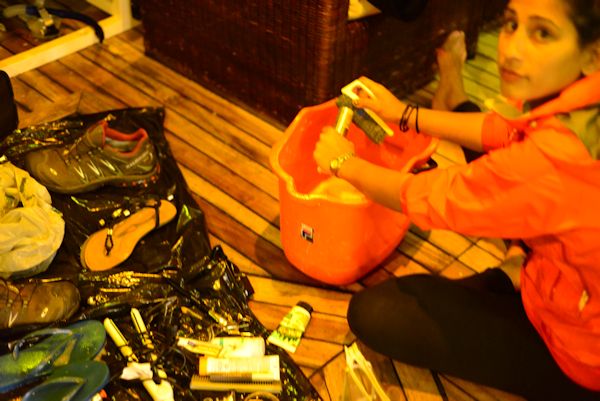
|
| These
photos are taken 10 minutes after our rescue. Here the emergency raft
and the dingy. |
|
One of the
tour members is trying to clean her belongings from the intense Diesel
smell. |
My camera equipment must be
done, the camera case was completely submerged multiple times under
water for several seconds, I hope the photos are recoverable. Hardware
can be replaced, photos not. Still, it’s equipment for a good $3000. It
sucks!
I don’t even want to look into
the case. Beth sits down and rests a bit, I go over in a quiet corner
and open the case. What a surprise! Except for a few minor drips, the
equipment is completely dry. The case is wet, but it protected the
equipment perfectly. Now I know why I spent $180 for the bag. I’m not
one that does advertising easily, but ThinkTank bags are worth every
penny and then some.
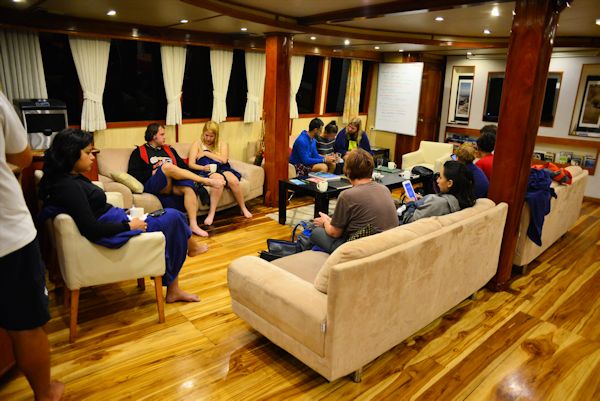
|
|
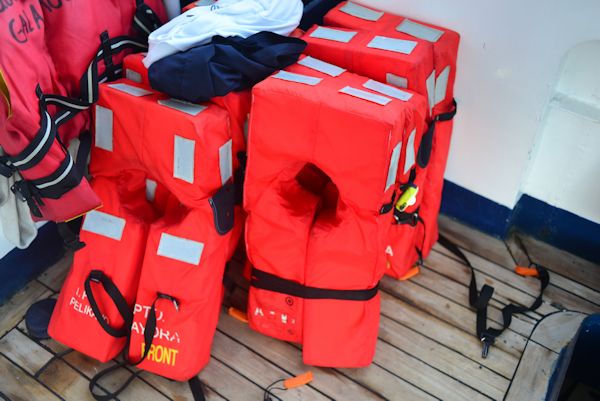
|
| We gather
around in the lobby of the 'Queen of the Galapagos'. We are all under
shock. Taking photos calms me down. |
|
The
lifevests we wore during the shipwreck. The one in front right was
mine. The emergency light that turns on by coming in contact with salt
water is still lit. |
With a hair dryer we are drying
all other wet clothes and things. We got word that the crew went back
to the wreck and the coast guard arrived at the wreck site as well. A
search for our stuff is on the way. About 45 minutes later we get a
notice that some of our stuff has been recovered from the wreckage.
Rachel and Dennis are getting their backpacks that have been recovered
from inside the boat. I get a jacket and a sleeping bag, both just reek
of Diesel. Diesel is one of the most resistant smells to get out of
anything, especially clothes. I don’t even bother and throw them in the
trash. We are on the lookout for our shoes, but they are nowhere to be
seen. Laurel hopes that her passport and/or Visa cards and money will
be recovered. In the corner I see my old Nikon underwater camera.
Unbelievable, they recovered it from our room in the wreckage. Being an
underwater camera, it is not damaged. It smells of Diesel, but cleans
up nicely. The other passengers get a few things back, but most them
smell so bad, they have to discard the ones without value. Rachael and
Dennis decide to keep all their things. From now on we can smell them
hundreds of meters away.
The captain of the Queen of the
Galapagos informs us that they have to go on to their next destination.
Their guests will wake up in a few hours and they shouldn’t have an
impact to their trip because of us. In the morning a ship will be
arranged that brings us ship wreckers back to Puerto Ayora. But we are
welcome to stay for breakfast. The Show must go on!
We are all sitting around and
talk about our ordeal. I take photos of everything, taking images gets
my mind of things. I also want to record as much as I can, for future
possible insurance purposes. I have no idea what time it is, my watch
is now on the bottom of the Pacific. But it’s getting light outside and
the Queen of the Galapagos slows down as she reaches her destination.
The weather is beautiful outside, a fantastic sunrise. We are anchored
before an island with bright red beaches. Blue footed Boobies dive bomb
down to catch fish. I would be an amazing day, but we are all not in
the mood to enjoy nature.
Meanwhile the guest of the
Queen of the Galapagos wake up and come out of their cabins to get
breakfast. They are on a very expensive cruise, the Queen of the
Galapagos is a luxury cruise ship. The guest are very surprised to us.
Naturally we all look a bit scruffy and tired. Not long and everybody
on the ship talks about us and our ordeal. We have to tell our stories
over and over again. Of course we are just an anecdote in their travel
tales. Who can blame them. “The cruise where we picked out real ship
wreckers”. Oh how would like to be in their footsteps. But I am one of
those shipwreckers…
We are no waiting for a word of
when our rescue ship will come. I have to admit I’m getting tired of
ships at the moment. Beth feels the same way. All we want now is to go
back to the main island to collect our thoughts, get some rest and plan
the rest of our trip. There are so many open questions.
The guests of the Queen of the
Galapagos are very nice, they make a little collection of clothes for
the ones who lost all of their clothes in the wreck. But unfortunately
the scene gets a bit out of hand as they all want souvenir shots with
us. “Smile for the camera”, they say, but we are not in a smiling mood.
After about an hour the word is
that the rescue boat is here. Excellent, I think. I go out and I can’t
see a boat anywhere. Then around the ships corner I see a tiny speed
boat. That can’t be it, I think to myself, the thing is barely big
enough to fit us all. We are 16 people altogether.
But sure enough this is the
boat. They can’t be serious… We get transferred over to the speedboat.
Another lifevest. We all sit down. “How long will it take to go back to
the main island?”, I ask the scruffy looking captain of the boat. “3
hours senior. And the ride will be somewhat rough.” Oh, my god! Three
hours on that thing. And “somewhat rough…” I know what that means.
The boat has two powerful
outboard motors. The captain gives it gas and we take off. The first 10
minutes are not too bad, but then we get out of the sheltered island
and enter the open sea. The boat just pounds in the waves, we get
thrown around and have to really hold on not to break our necks.
Wrapped in a blanket we spot the Captain of the Pelikano. This is the
first time we see the guy since the wreck. He doesn’t say a word to us,
just sits down in a cubby hole and stares. We are not talking to him, I
might say something I would regret later. I’m convinced the Idiot fell
asleep and ran us a ground. There is no other explanation for the
accident. Even if all electronics didn’t work, he would have seen the
lighthouse, that’s what it’s for. Those are the thoughts running
through my head.
After 1 hour we are totally
exhausted. The little boat gets pounded so severely by the waves the
captain – or better the driver – has to slow down or it will break
apart. It is totally apparent that the little boat is not built for
this kind of thing, especially not with that many people onboard.
I take out my little GPS. I
want to see where we are at, I want to calculate for myself how far we
are away from Puerto Ayora and how long it will take at our current
speed. I don’t trust the Ecuadorians anymore. The GPS doesn’t lie and
according to the distance we still have to go and the current speed, it
will still take us more then 3.5 hours to the port. Did they calculate
the fuel correctly? Do they even have a radio on board?
After another half an hour my
worst fears come true. The engines don’t sound right and we smell a
strong odor of gasoline. We are relatively close to the coast, but the
waves are pounding onto a lava beach that is sharp and rugged. If we
are getting thrown against those rocks, we are history. That’s when the
engine die completely. The captain comes down from his driving seat. He
and a crewmember of the Pelikano palaver pointing to the engines. He
opens a cubby hole and digs out of a filthy box what looks like a fuel
filter. The whole boat smells like a gas station, I hope they are smart
enough not to smoke a cigarette now. We are getting dangerously close
to the coast with its pounding waves. He tries to start the engines,
but they are flooded with gas. He tries again and thank god they start.
For about 2 hours the engines
run good. Dolphins and Manta rays jump out the water. Even the biggest
ordeal sometimes has it’s fascinating sides.
All over sudden the gasoline
smell is back stronger then ever. The engines start to stutter again.
He reduces the speed. I overhear a conversation with another crew
member. He doesn’t have another fuel filter! We are about 45 minutes
away from the port. The engines barely run now and he drives at one
fourth of the power. We are hanging over the boats side to get fresh
air. Others try to cover their nose and mouth with a piece of clothes.
I’m dizzy from the gas smell. Beth is pale, I’m worried because she has
an allergy to some chemicals and she has asthma. How much bad luck can
you have? Who knew the ‘rescue’ is just as bad as the shipwreck? By now
we are sitting in a puddle of gasoline inside the boat. The engines are
so oversaturated with gas, they can’t burn it anymore and squirt it out
into the boat. The gasonline starts to burn our feet. The GPS says we
are only 5 minutes away from something called ‘tortuga beach’, that
must be a sandy beach. It’s about 10 km away from Puerta Ayora. I think
he should land the ship there and we walk the rest. At this point
anything is better than to die from the fumes. It’s that bad! I make
the suggestion, but nobody really pays attention.
“10 more minutes”, he says. 20
minutes later we limp into the harbor of Puerta Ayora. The engines die
just at the second we get tied up on the pier. Hallelujah we are on dry
land! Right on the pier were we land two Police guys are standing and
we assume that now we are getting taking care of by the officials and
coast guard. But the police makes no effort to talk to us. Instead we
are greeted by a tour operator from a company I have never heard
before. We booked our tour with “Gecko’s” from Australia, the
representative is from “Peak” in Edcuador. He explains “Peak” is
authorized to deal on “Gecko’s” behalf. We are all getting loaded into
two pickup trucks. The representative seems to be in a hurry. Now in
retrospect I’m convinced the Police was not there to protect or help
us, they were there to protect the local interests from us! They were
looking out that we can’t talk to other tourists or journalists which I
expected to see when we arrived. But that realization took place weeks
later.
All we want to do at the moment
is to get some rest. The representative explains to us that we are
brought into a hotel and we shouldn’t worry, everything will be taking
care of. And unfortunately this is what worries me the most.
I explain to him that for
starters we all need shoes before we go into a hotel. We can’t run
around barefoot. I don’t want to step in a piece of glass or something
like that. It’s clear that he has his instructions from somebody in the
background and he is a bit uncomfortable diverting from a plan that
obviously has been layed out. After my request he talks on his
cell-phone in a quiet corner. “Ok, we can go to a shoe store. Be aware
that everything in Galapagos is expensive, because it needs to get
flown in.”, he says. Well, we need shoes, no matter what they cost.
They are absolutely essential. It’s actually funny, how something that
trivial like shoes can become very important if you don’t have them.
Plus we all assume that the shoes will be paid by the tour operator. We
tell him that. Unbelievably, he has to make another call to confirm. I
have a feeling that in the next 48 hours he will call a lot.
The shoe store has a lot of
shoes, but not in our sizes. We all either end up in Flip-Flops like
Beth or my crappy $20 sneakers that actually cost US$100. They were the
only pair that fit. This store clearly is for tourists only, no local
could afford to buy shoes here. I ask if there is another shoe store in
town were the locals buy. He says no. I know he is lying. We have to
pay with our own money, but get instructed to keep the receipt for
later re-imbursement. Laurel from Australia doesn’t have any money. In
fact she doesn’t have anything except a t-shirt and some sweat pants
and a little bag that the good people of the Queen of the Galapagos
gave her. The representative has no choice – after another phone call –
to pay for her shoes.
We are transferred to the
hotel. It’s a nice hotel and we all get our own rooms. The
representative sees my bloody knees and shins from my fall during the
wreck and asks, if I’m ok. “Actually I’m not.”, I say, “I think I would
like to see a doctor.” The wounds are not too bad, but it’s always good
to get this stuff checked out. He says, he will arrange one. Right
around the corner there is a modern hospital, they even have a
decompression chamber for diving accidents. The clinic is squeaky
clean, it could be a positive example for many western countries
including Canada.
The Doctor is very nice and
competent, speaks English very well. He checks me out and gives me an
antibiotic cream for my wounds.
Back in the hotel I report back
to the other ship wreckers and tell them about the nice hospital.
Everybody decides it is a good idea to get checked as well.
After about 3 hours we are
ready get something to eat and the representative – after a phone call
– invites all us of for dinner in a local restaurant. He says he will
use the time to write down our concerns so that he can address them
with his superiors. When we sit down and he starts to write down our
‘concerns’. When he starts telling us that they never lost a ship and
this is a big loss for the company, my patience ends. I speak up:
“First of all, we are all fine, thank you! Not once since the ship sank
has anybody of the crew, nor the representative asked us this question.
Next, I would like somewhat of an apology from somebody in charge. Put
your boss on speaker phone so I can ask him why he is not here, because
quite frankly I don’t give a darn about your ship. We almost died last
night! That is what counts. Third, I would like to know what happened.
We all spent thousands of Dollars and our hard earned vacation to be
here. I would like to know your company’s concerns plus a solution to
our obvious problems.
Lastly, I want to express concerns about the safety of your cruises and
the fact that we didn’t even get a Safety briefing. Who is responsible
for this mess and who is responsible for cleaning it up?”
Everybody is in agreement, the
representative is pale in the face. “You didn’t get a safety briefing?
– Oh, my god!” It seems this struck a nerve. Even in Ecuador this seems
to a major oversight. Maybe this is something they could be sued for,
maybe they won’t get insurance compensation when this comes out. But
that’s not my goal. I just want to make sure they know “Hey! We are
here, deal with us first.” Arbi, the fellow from England is just as fed
up as I am, he voices his concerns loud and clear as well.
He assures us that everything
will be taken care of when we go back to Quito. There is not much he
can do here in the Galapagos, he has to do what his boss tells him to
and has very little authority. I believe him and assure him that we are
not mad at him. But we want to get as open a communication as possible
and want everything to be dealt with swiftly as we are all on vacation
and we don’t want to lose the rest of our vacation to bureaucratic
paperwork. Deep in my heart I know this won’t be possible and we will
deal with this for a long time. Basically our vacation is over. Our
flight is booked back to Quito for the next day. Laurel has lost her
passport and nobody knows how she will get back to Quito, let alone
carry on her 3 month trip through South America. She is totally lost
and has no money, no credit cards. We can tell she is a very proud
individual and won’t take any presents or handouts from anybody. The
people on the Queen of the Galapagos had to convince her to take the
old T-shirt she is wearing right now.
Beth and I talk about how to help her without hurting her pride. We are
handing her $200 and tell her “Laurel, whatever happens next, you can’t
be without money. This is a loan, you can pay us back whenever you are
back in Australia.” She accepts it with tears in her eyes. “But it’s
only a loan!”, she says.
After dinner the “shipwreckers”
have a little get-together in the Hotel Lobby to discuss what happens
next. Most of are going back to Quito tomorrow and although we are all
in different hotels all over the city, we decide to stay together as
much as possible in order to coordinate our next steps. We decide not
to sign any ‘agreements’ without consulting each other. Those
agreements will undoubtedly be handed to us in the next days.
I just dread the next days.
There is nothing worse in a foreign country then bureaucratic
paperwork. Beth and I check online if we have to report Beth’s damaged
passport to the embassy. The water stain is relatively small, her face
is still clearly visible. We read that any damage on the picture
renders the passport void. Back in Quito we better check with the
Canadian embassy. We are lucky that Quito has a Canadian Embassy.
Australia doesn’t and that really worries Laurel.
Next day most of us are at the
tiny airport of Santa Cruz. The Danish couple decided to go on another
cruise. They must have nerves of steel, I wouldn’t have the nerve for
that right now. I guess they think ‘if you fall from the horse, you
should get right back up.’ But they didn’t lose anything and their
passports have not been damaged, so they won’t have much of a follow up
paperwork.
Between Beth and I we calculate
that we lost about $3000 worth of travel gear. It’s amazing how quickly
things add up. Our goal for the next days is to make sure, we get this
back as well as a refund for the cruise. With this and sorting out the
passport issue we probably have enough on our hands. But we hope we can
at least salvage a bit of next week and do some side trips from Quito.
Should the passport issue turn out to be quickly resolved by the
Canadians, we might fly to Cuenca. I really would like to see Pater
Crespi’s collection.
From a distance we watch
Laurel’s progress in getting on the plane. She has no passport or
papers whatsoever. In this day and age this is a problem with air
travel, even on a tiny airport on the Galapagos Islands on an inner
country flight. In passing she gives us short updates on her progress.
It ranges from “no problem” to “absolutely not possible” depending on
who she is talking to.
After two hours we are all
onboard the plane, including Laurel.
On the airport in Quito, a
‘delegation’ is waiting for us. My speech yesterday seems to have made
an impression. A lady – Maria - introduces herself as the ship’s owner.
Her sister is here as well, I guess it’s a family business. Fausto is
the manager of Peak Ecuador, he is the representative of Gecko’s as
well.
For the first time, somebody says “We are sorry what happened. We will
take care of you and set everything right.” That’s a start.
Understandably they don’t want to talk business at the airport, they
invite us for dinner in the evening to talk about everything. Outside
is a van waiting that will bring us back to the hotel.
In the evening we are invited
to Quito’s finest restaurant. By now some of us are wearing the same
clothes for the last three days. Needless to say we look a bit out of
place in the classy restaurant right across the Presidential palace.
Maria and her sister – decorated in Gold, Diamonds and leopard print
pants – start talking while the Gaston serves the traditional South
American potato cream soup, a specialty to die for.
We will be fully compensated
for our trip and the items we lost. Fausto, Peak’s manager, will handle
the compensation for our cruise, Maria and her company will handle the
compensation for the things we lost on during the shipwreck. All she
needs is a list of the things we lost with an approximate value
attached. She says she might be able to pay us even before we go back
to Canada or wherever we are from. Meanwhile they will personally
accompany us to the shopping mall in Quito and we can buy whatever we
need. As a personal apology to us all she will invite us all to a free
cruise on her second ship, a catamaran within the next two years. It’s
a 10 day luxury cruise so we can see the Galapagos Islands in their
full glory. Everything sounds fantastic and everybody seems very
enthusiastic. She explains to us that she is terrified of bad press and
bad reputation on the Internet. Is we need anything we should just tell
her and she will arrange it. She will drive us to wherever we need to
go, starting tomorrow with a trip to the shopping mall.
Everybody seems very relieved,
but Beth and I are skeptic. It all sounds a bit too good to be true. We
are not telling the others, they are very enthusiastic and we don’t
want to ruin the mood. In the end our doubts should be proven somewhat
correct.
But the next
day everything Maria said seems to be true. In the morning she is in
our hotel. We told her last night that we are taking her by her word as
we would like a ride to the Canadian embassy and we have no idea where
it is. We want to get the passport story over with. We have still 5
days left in our vacation, maybe we can salvage some of it. We are
pretty certain there is a temporary document of some sort that says
something like “This passport is genuine, it has been damaged,
sincerest the Canadian Embassy.” On the Internet we found out that the
embassy’s opening hours are very convenient from 10:00 – 13:00.
Convenient for the embassy personnel, I mean. The traffic in Quito is
horrendous it doesn’t help that Maria’s SUV (with leather everything
and golden shifter knob) driven by her sister is running on fumes. The
emergency gas light is on, it can’t be lit any brighter. I’m sure the
two women don’t even know how to gas up, this is probably done by a
buttler of some sort in the garage of the climate controlled mansion.
Unfortunately he forgot to do that today. I try to ignore the gas gauge
and look how we drive the busy streets.
After 15 minutes we are told by
a lady who is actually brave enough not to wear a bulletproof west or
knight armour in the completely empty embassy to enter interview room
#2.
#2 is hardly big enough for two
people to sit. The embassy personnel sits again behind bulletproof
glass. The room reminds me of the visitors room of a high security
prison. A lady enters and asks what brings us here. Beth tells her that
she is a Canadian citizen and unfortunately her passport got damaged
during a boating accident. She puts the passport in a
bullet-and-everything-else-proof sliding mechanism so the lady can see
it. The lady has a strong accent, she is hard to understand. She is
definitely not Canadian. I was always under the impression that in
embassies people from the country of the embassy is working, but I was
obviously mistaken.
She takes a look at the
passport and says “This is damaged. You can’t travel with that!”. Beth
says, “yes, I know, this is why I’m here. What do I have to do now?”
“Do you want a replacement passport?”, the lady says. Beth asks “Well,
do I need one?”. “Yes, if you want to travel…”, is the response.
I’m shaking in my chair. It’s the travel agency from Quito all over
again. I can’t believe the Canadian embassy doesn’t employ friendly
Canadian staff, who actually wants to help.
I can’t hold it in and say “Look, my wife’s passport has been damaged
and yes, we would like to travel. We are from Canada, our vacation ends
in five days. Yes, we would like to fly back as we do not want to stay
in Ecuador. That’s why we need you to tell us if there is a temporary
travel document in a case like this that the embassy can provide us
with.”
“There is only a temporary
passport. You have to apply for it. It takes at least three days and we
need references. It costs $180 and I have to keep this passport as it’s
damaged.”, she says. “We know it’s damaged. But the passport is brand
new and the Canadian government prides itself to mention that their
passport has 126 security features, one of which is damaged. I’m sure
you have the ability here in the Embassy of the sovereign State of
Canada to determine if this passport is genuine or not. Is there no
letter the embassy can issue so that we can travel back to Canada with
this passport?”
“No, sorry. We can’t determine
that this is a genuine passport.”, she says. “The only way is to apply
for a temporary passport. We need you to pay right away with a major
credit card as we don’t accept cash here. Then we need three references
from people that know you more then 5 years. And you need to provide us
with passport photos with the exact specifications for a Canadian
passport. If you decide to go this route, I have to confiscate the
damaged passport right away, you can’t have it back.”
“You are taking away my only
travel document I have? I’m in a foreign country! What if something
happens and I need to proof who I am?”, Beth asks. The lady on the
other side of the glass has a look on her face that I have seen often
in Ecuador. It says “I don’t care and don’t waste my time. When can I
go home?”
I wisper to Beth “Just do it, we won’t get anywhere.” The lady says,
“Are you sure?”. I really have to hold back now. What a stupid
question. She just told us there is no other option. I feel like
screaming, but smile instead.
“Yes, we are sure!”
Of course we pay first. Then we get handed a form that is too
complicated to fill out then end there. We decide we will have to fill
it out in the hotel when we have peace and quiet. We also have to come
up with 5 references that know Beth for 5 years in Canada and that are
home. The lady tells us the embassy will call them, if they can’t get a
hold of them, we might not get the temporary passport. I’m sick to my
stomach, Beth is pale. I hand back the key to my cell phone which gets
handed back to me through a security window.
We are standing in the streets
of Quito and Beth has no passport. No identification whatsoever. I had
a hunch before we entered the embassy and took a photograph of her
passport with my camera. This is now the only official proof of her
existence. Isn’t it the job of an embassy to help their citizens
abroad? Isn’t this the main duty of an embassy? Let’s see what tomorrow
brings.
At 11:00 we are back at the
embassy. It takes us two hours with the taxi to go there. Three Taxi
drivers refused to drive us there. (This is a first, I have never
encountered this phenomenon in any other country.)
In a 3 hour sitting in the
hotel we filled out the form for the temporary passport. For the five
references we have the idea to let the embassy call at work in Beth’s
department, so the embassy can do everything in one phone call.
Yesterday we Skyped work to make sure who is working. References are
big in Canada and a foreign concept to me as a German that I will never
get used to. Pretty much everything works with references, official
papers, job applications etc. Without references you are nobody. This
concept comes from the olden days of “suspicion and small villages”
where everybody knew everybody and strangers were not wanted. “Nobody
knows you – you can’t be any good!”
Like it or not, this is how it works.
There is a little photo studio
a block away from the embassy, so we stop there to get Beth photo for
the temporary passport taken. It’s an old fashioned photo studio with
an actual photographer who knows what he is doing. Refreshing to see
businesses like these still exist somewhere in the world. He get’s the
photos right first dry.
Back at the embassy the lady
that dealt with us the day before is not available. We think this is a
good thing. Sure enough the staff member that helps us today is nicer.
Yesterday we talked to Arbi, the guy from England, and he told us that
the British embassy we went to was much more helpful. He reported the
shipwreck to them and they told him to investigate. We decide to do the
same and report our ordeal to the Canadians. The lady writes everything
down on some sticky notes and shows genuine concern. But obviously the
Canadian government does not have any official procedures to help their
citizens abroad if they are in trouble. Surprising as everything else
is heavily regulated and there seems to be a form for
everything.
But the staff member from today
– unfortunately I forgot her name – makes it a much more pleasant
experience. It’s amazing how things change if people make an effort to
deal with you properly. She tells us that this is considered a serious
incident and the embassy will follow up and will let us know what
happens. They never did. We are informed that the passport will be
ready on Thursday. It’s Tuesday today and our flight back is on Friday.
There is no room for error, if there is something wrong with our
paperwork, we will have no time to fix it. We beg the lady to check our
papers and the photos double and triple times before we leave. One last
thing she advices us to do is file a Police report.
Now we know we are stuck in and
around Quito for the rest of our vacation. No Cuenca, no Pater Crespi.
Without a passport or other form of identification tourists can’t take
commercial airplanes or long distance busses. We can’t even book a
tour, as they also require ID. We decide to make the best of it and
explore Quito’s shops and restaurants. We also want to go to Otavalo,
one hour northwest of Quito. Apparently the biggest crafts market of
South America is there.
But first we get an email from
Maria. We should come to her office. We think, maybe we will get our
money. Nobody has heard from Fausto, the manager who is supposed to
deal with the refund from the tour operator. Arbi tried several times
to get a hold of him over the last two days, but he either just left
the office or is not in the office, yet. Arbi personally went to his
office and personally saw him there. 10 minutes later he was gone to an
urgent meeting. Arbi told us he got pretty loud in the office as he
realized that he was taken for a fool.
We take a Taxi to Maria’s
office. She tells us that she has ‘good news’. Her insurance company is
willing to pay up to $1200 for lost items during the wreck. I tell her
we lost more than that. Some people lost a whole lot more.
She says that this is what her
insurance offers her to pay right away. Anything more would take a long
time as we would have to fight for it. We think to ourselves: Fight for
it? How? From Canada? In Canada you can’t even get a lawyer that will
talk to you under a case value of $50000, let alone afford one. And
then how do you fight something like an insurance company in another
country?
We also have to be careful that
if we want too much money, Maria’s company will just declare bankruptcy
and we will get nothing. I’m convinced that they already think about
this option. Every smart business person would. If they do that, we
won't see a cent.
So we say “Ok. $1200 per person
for lost items. When can we get the money?”. “We can wire the money to
your account by Friday, or early next week.”, she says. That sounds
good if it’s true. We sign a form that says something like “We agree
for a maximum compensation of $1200 per person for lost items during
the shipwreck of the Pelicano.”, and leave the office. We want to use
the rest of the day to go to Otavalo and see the market that the travel
guide (now on the bottom of the ocean) was raving about. It’s certainly
nice and lot’s of colorful art is displayed. Lot’s of locally handmade
stuff but also imported made in China items. You have to be careful
what you buy. We buy a nice vase and a very nice handmade blanket.
The market feels a bit ‘commercial’, by far not as authentic compared
to the Peruvian markets we visited before.
The bus ride back to Quito takes three times as long as going there. We
do not enjoy our time. It’s official, we are not in the mood for
vacation anymore, for the first time since 25 years of traveling I feel
this way. Today we feel that we just want to go home.
Next day we feel a bit better.
The sun is out. But today we have to go to the Police and report the
incident. A representative from Maria’s company will help us, as we
don’t speak any Spanish. Somebody recommended a specific police
station. Apparently they have English speaking staff there.
But before we go I write an
Email to our tour operator Gecko’s with whom we booked the Galapagos
trip. I don’t trust that Fausto guy to arrange anything. I have a bad
feeling about him. I describe the problem and want to know if they even
know about the incident. The answer comes about half an hour later.
They just heard about it yesterday from the Coast Guard. Fausto did not
report anything. Gecko’s apologizes for the terrible ordeal we went
through and will issue a refund immediately as soon as they receive our
bank information. An hour later the money is on our account. That’s
good customer service. We can breathe a bit easier now. We are not rich
people and saved our hard earned cash on the Galapagos trip which was a
big part of our expenses. At least financially the loss is not that big
now.
Let’s go to the police. The guy
Maria sent to accompany us to the police has his little daughter with
him. It’s his day off today. I feel bad for him and especially the
little girl. This is probably the only day with her dad for her and she
has to spend it with us in a boring police station. She is ten years
old and already speaks a bit of English. Her dad tells us that nowadays
it is crucial for kids to learn English as soon as possible as only in
the tourist industry money can be made and more and more staff only
get’s hired if they speak the universal language of the world.
We are taking a Taxi. It is
amazing how all over sudden prices change, if a local is in the taxi.
Where we would have paid $4 for a trip before, now it’s $0.50. This is
something I don’t like. I find people that rip off the ones that can’t
know or are helpless are fundamentally dishonest. In Ecuador we met the
highest concentration of dishonest people so far.
We arrive at the police station
fairly quickly as traffic is very light today. It’s a holiday and on
top of everything there is the football match Ecuador – Uruguay on.
It’s a very important game. The winner will go to the 2014 world
championship end-round in Brazil, the looser will stay home. Too bad we
have to go to the Police Station. The game is in Quito and that would
have been a blast to see. I’m a huge football fan and Beth has never
been to a real football game before. On the way to the police station
we pass the stadium with lot’s of colorful fans around. Oh man!
While I see the excited fans a thought pops in my head. Everybody will
be in front of the TV. I mean EVERYBODY! Policemen included. I doubt we
will find anybody that even wants to deal with us.
I hate to be right with things
like these. But when we arrive at the police station, a lot of words
are exchanged between the Police guy and … The police man is very
careful not to lose sight of the little TV next to him. Basically the
outcome of the conversation is that this Police Station is not dealing
with our case. Officially the reasons are not known, but I know the
unofficial reason. So we head out to the next Police Station which is
supposed to be the main station in Quito. At the gate the police men
shake their head. A major discussion breaks out between them and …
Palaver! Hands are making gestures back and forth.
After several minutes we are
waved into the main building of the Police Station. It’s a huge, modern
building with polished marble floors. The offices are divided by glass
walls. We are guided to a waiting area where about 20 people sit and
sleep. One woman with a black eye is in tears. She seems to be
accompanied by her mother. In this respect, Police Stations and
hospitals all over the world are the same.
Three offices are occupied by
police officers that help people. All over sudden the all get up and
leave. David runs after them. Palaver! Hands are making gestures back
and
forth. My interpretation of the scene is that the football game has
started and the police officers want to watch it. They don’t give a
darn about how many people are sitting in the waiting area. David
realizes
that we would have to wait now at least the duration of the football
game to get service. He gets up and wants to stop them. Will he be
successful?
After a long discussion two of
the officers leave, one – the youngest – turns around and comes back.
His facial expression looks like a small child in the supermarket that
had a tamper tantrum for some candy, fought with his mother, but lost.
He goes back into his office
and waves the next customer in. David comes back and takes a seat right
next to me. “What was the problem?” I ask. “No problem!” He says. The
usual answer. But his red face says otherwise.
After about
an hour people that
came well after us are waved into the office by the police officer.
David jumps up again and storms into the office. With the glass walls
we can
see everything that is happening. Palaver! Hands are making gestures
back and fourth. I think the problem is now that the Police officer
doesn’t want to deal with some foreigners. Shipwreck? That sounds
complicated.
After ten minutes of discussion
– I admire David's stamina, but I guess this is how things are done
here – we
are waved into the office. The Officer doesn’t speak a word of English.
Thanks god David is here to translate.
We would have never succeeded without him.
We describe how the shipwreck happened. I’m pretty sure the translation
is not 100% accurate, controversial thing we say and could get Maria’s
company in trouble are being omitted. I don’t care anymore. I just want
to get out of here. “What a nightmare this all has become. Our precious
vacation! A whole week of Bulls**! Tomorrow we have to go to this darn
embassy again. Let’s hope we are getting the temporary passport now
without problems.” These are all thoughts that go through my head. The
Police offer is saying something to me, I don’t really pay attention. I
naught. Sure! Whatever you say! I smile. He prints of a report and
hands it to us. We thank him and leave. I quickly glance over the
report. At least we have something official now from the police for
Insurances, border guards or whoever wants or needs to see it.
We come back to the hotel at
17:00. We are mentally exhausted beyond description. In the evening we
just stroll through the old town of Quito that we know very well by
now. We are treating ourselves to a nice restaurant that we discovered
the other day. Next day we are on our way to the embassy again. We
didn’t get a call or an email, which we think is a good sign. Will the
temporary passport be ready without a problem? Our heart are beating in
our chests. We are going through the security procedures again and
finally talk to the Canadian representative that hands over Beth’s
temporary passport. It truly is temporary. A simple white piece of
paper, stapled together in the middle with a laminated insert. Cut kind
of crooked. This thing costs $180? I don’t even want to think about it!
But we have it, now we can travel back home. The staff member says the
following soothing words. “Here is your passport. Should you have any
problems, with border guards, tell them to call the embassy.” “Yeah,
right!” I think, “Our flight is going at midnight, the embassy is open
from 11:00 – 15:00! I’m sure the border guard would get great
information then”
The next day we shop a bit and
finally fly back via the US to Canada. We don’t have any problems with
the temporary passport. It seems everything is marked in the computer
already and the border guards are already aware of the situation. We
are glad when we come home to Calgary. This was certainly the worst
experience we ever had during our travels.
Our trip to Ecuador leaves us
with very mixed feelings about the country. Of course we are a bit
tainted because of our ordeal in the Galapagos Islands and the
aftermath. But I think we are experienced travelers and we believe we
can judge those things quite well. We had two great weeks in the Amazon
Jungle and good days in the old town of Quito. The country is certainly
beautiful and has lot of diversity to offer. What left a sour taste in
our mouths was the fact that many Ecuadorians we met were quite
dishonest, unmotivated, grumpy and inflexible. The women we met and
dealt with had a bit of a tendency to be ‘divas’ and the men had a lot
of ‘machismo’ especially towards women. A lot of the guides made
inappropriate sexist comments towards female guests and left us with
the impression that single women travelers should be careful. This is
something we have not experienced in Peru or Bolivia or anywhere else
in that form.
Another thing we didn’t like
were two different prices for locals and tourists in many museums, and
other attractions which gave us the impression that tour operators,
restaurants etc. think they have a ‘license to rip off’ tourists. All
third world countries have the usual ‘harassers’ that want to sell you
something in the street and when you stand in front of the stores.
That’s fine and somewhat expected. But in all of my travels around the
world I have never experienced a downright hostility and nasty comments
when we said “No, thank you”. I sometimes had the feeling that there is
a deeply routed disrespect for tourists and strangers.
Maybe this is somewhat
historical and cultural in Ecuador as the guide in the Amazon told us
that many tribes in the Ecuadorian jungle immediately kill any stranger
without warning that enters their land. Even he has to be careful not
to enter certain areas.
Another thing to watch for is
the practice of well established tour operators to sub-contract local
tour operators (this is not just for Ecuador). You think you are
booking a tour with a well established and experienced global tour
operator, but once there you find out that an inexperienced local guy
is just a ‘representative’ who’s training was wearing the operator’s
t-shirt with a logo and holding up a sign at the airport. It is highly
recommended while booking to ask who the local representative is going
to be as well as asking for accurate contact numbers.
Maybe – someday – we will give
Ecuador another try. I still want to see Pater Crespi’s collection.
Aftermath:
After
we left Ecuador communication between Maria’s Office and us
“Shipwreckers” ended entirely. While we stayed in touch with each other
as best as possible, no efforts were successful to contact Maria or her
office. No sign of the $1200 either.
6 weeks I decided it’s time to increase the pressure a bit. With
several emails and deadlines I finally got a response. She claimed the
insurance was slow and no communication from the insurance was
received. Finally, 3 months and numerous emails we got our promised
compensation of $1200.
We are all still waiting for the voucher for the promised replacement
cruise.
But that – we think – will
never happen.
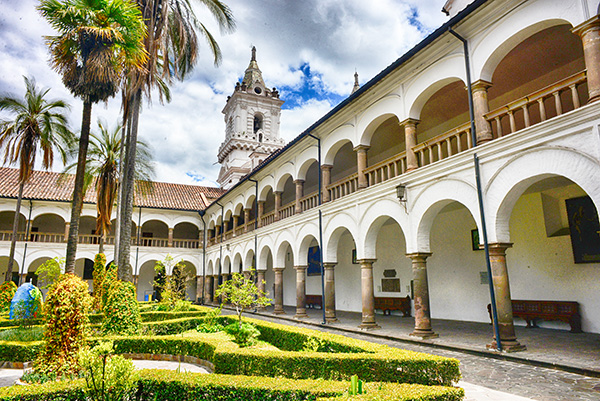 |
|
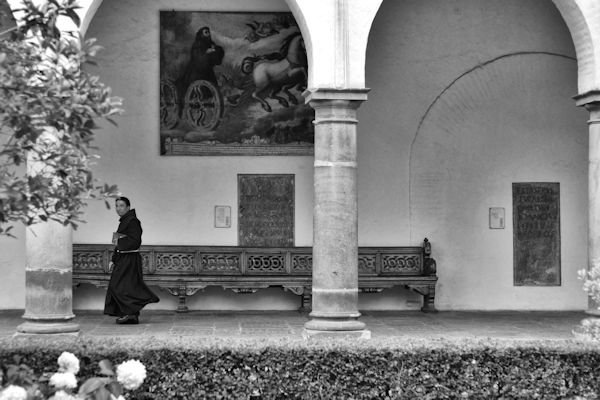 |
| After all
the chaos over the last days, we enjoy the tranquility of the monastery
'San Francisco' |
|
Some
munchs live here like hundreds of years ago. |
